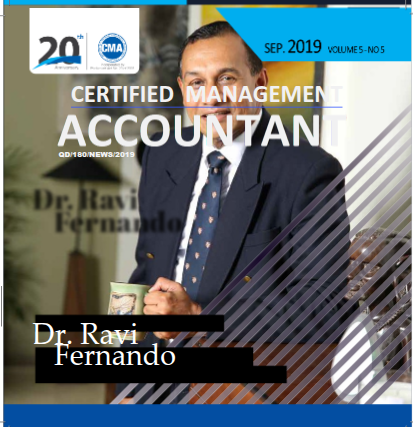
“Strategic Corporate Sustainability is not about how money is spent,it’s about how money is made”
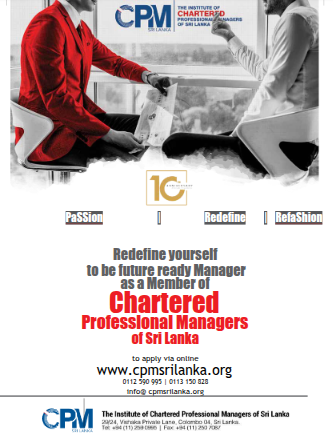
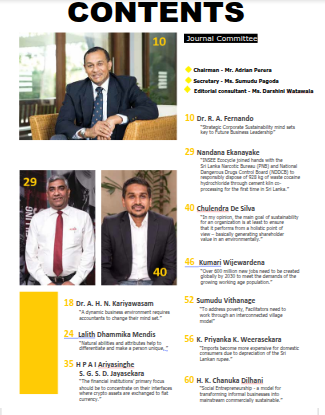
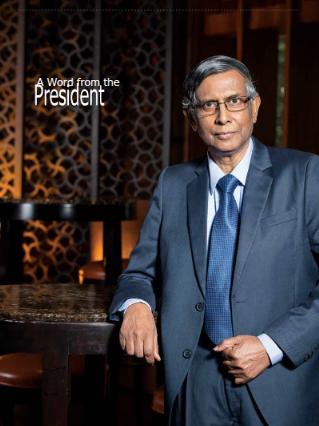

Message from the
Chairman
of the Journal Commitee
2019 marks the 20th Anniversary of establishing Certified Management Accountants CMA”) of Sri Lanka the National Management Accounting body. Since then CMA Sri Lanka has come a long way in terms of recognition locally and globally in keeping with that,CMA Journal has achieved the status of
truly professional journal among the finance professionals and the business community.
This year the committee decided to focus on Sustainable Development Goals Agenda 2030-The Role of Professional Accountants”. Being Finance professionals we are
called upon to take more responsibility when it comes to our role in business sphere. In addition accountants are expected to take long term view rather than short term views in business which is not always the case.
CMA journal has been improved to a level to be one of the best journals in South Asia Region and our expectation is to achieve the level of being the best in Asian Region and we are confident of achieving that place in the coming years.
CMA Sri Lanka has provided opportunities for professional members to share their valuable experience in different business spheres by providing articles to the journal so that, other members will also benefit as whole.
The journal is for the members and we hope our members will contribute
more of their experience to the journal which will be an additional source of knowledge for our members.
I take this opportunity to thank Prof.Luxhman R Watawela founder President and President of CMA Sri Lanka for the guidance given to us,the council members and paper contributors and the staff of CMA
Sri Lanka for their unstinted support.

Adrian Perera
MBA(Sri J), FCCA, FCMA, FCMA(UK),
CGMA,FCPM and Asso.Member of Institute of Bankers of Sri Lanka
CERTIFIED MANAGEMENT ACCOUNTANT
Induction of CMA Sri Lanka President and Council Members 2019-2021
The fourth election to the council was held on the 9th May 2019. The new Act provided for a President, Vice President, three council members to be elected and three to be nominated by designated institutions from the Central Bank of Sri Lanka, Department of Accounting University of Sri Jayawardenapura and the Institute of Chartered Accountants of Sri Lanka.
The council of CMA Sri Lanka as per the incorporation Parliament Act No. 23 of 2009 for the year 2019 to 2021 are as follows:
Prof. Lakshman R Watawala
President
Mr. Hennayake Mudiyanselage Hennayake Bandara
Vice President
Mr. Merrinnage Ruchira Asanka Perera
Council Member
Mr. Weerakoon Arachchige Adrian Damian Perera
Council Member
Mr. Jayasekera Mudiyanselage Udaya Bandara Jayasekera
Council Member
Mr. Manil Jayasinghe
Council Member
Mrs. Kumari Wijewardena
Council Member
Dr. Harendra Kariyawasam
Council Member
www.cma-srilanka.org | Volume 07 -No. 4 – September 2019 Page 9
CERTIFIED MANAGEMENT ACCOUNTANT
How do you define “Strategic Corporate
Sustainability”?
At the Outset, let me first share with you how the concept originated. Whilst reading for my Master’s Degree at Cambridge University, I focused on understanding ‘What makes some business embed sustainability in corporate strategy?’. It must be mentioned that under 3% of Business have actually done so. This led to a research study of all those UN Global Compact signatory companies in a National network to establish and identify ‘Common factors’ which set apart those companies which did so. This led to the concept of Strategic Corporate Sustainability -7 Imperatives for Sustainable biusiness’.
When ever the question of Sustainability strategy is posed to most business or National leaders, their response immediately migrates to CSR activities and how much money was spent on such activities as a % of the generated revenue or profit. This is an explanation of generated revenue or

Enlightened triple bottom line business leaders who are conversant with Strategic Corporate Sustainability know what matters is How money
is MADE? They focus on creating a ‘Sustainable profit generating business model, which does NOT impact the planet negatively, but contributes to social progress of people.’
www.cma-srilanka.org | Volume 07 -No. 4 – September 2019 Page 11
Strategic Corporate Sustainability, as defined below requires business to meet two non-negotiable criteria:
- The organization must embed Sustainability/Triple bottom line strategy in Corporate strategy.
- The organization will differentiate itself on a Sustaianbility led/triple bottom line paradigm.
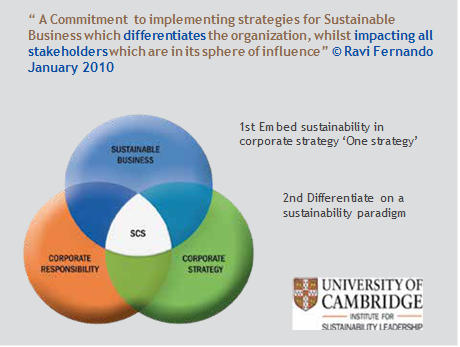
The subject is comprehensively articulated in the publication shown below’.
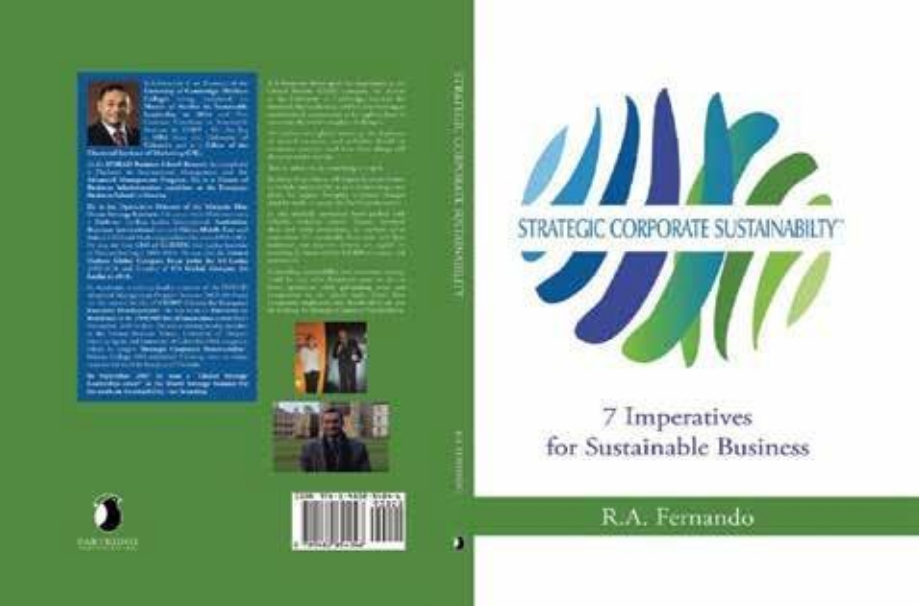
Page 12 www.cma-srilanka.org | Volume 07 – No. 4 – September 2019

Extreme weather events 2
Failure of climate change mitigation & adaptation 4

Source: Global Risks Perception Survey 2017-2018, World Economics Forum
At the World Economic Forum ‘Risk Report’ 2017/2018, the above 5 risks were highlighted as being the ones to have the biggest impact on both nations and business in the next 10 years. 2028-2030! A closer examination confirms that Risk
2-3-4 & 5 all stem from Climate Change /Climate Emergency factors which are linked to the environment which is by and large as a result of human action. The majority of them are caused by the ‘unprecedented’ burining of fossil fuels (Coal, Petroleum, Diesel and natural gas) which has led to global warming with most nations recording the highest ever temperatures in 2000 years! In fact the past 19 years since the year 2000 are the ‘hottest’ ever recorded.
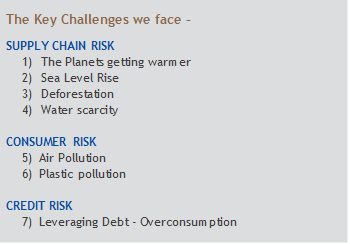
If one was to look closer at the end result of this unprecedented Global warming, the end result of burning fossil fuels is that global supply chains and end consumers are directly affected and will face the brunt of the Climate emergency in every nation of the planet unless we are able to urgently STOP burning fossil fuels and move 100% to renewable energy sources. The planet has heated up +1 degree centigrade from the average temperatures recorded in the pre industrial revolution 1880 period and set to cross between +1.5 Degrees to + 3.7 Degree Centigrade and the global crises of climate emergency and the associated losses to global GDP is captured in the IPCC (International Panel of Climate Change) in October 2018 as follows:
www.cma-srilanka.org | Volume 07 -No. 4 – September 2019 Page 13
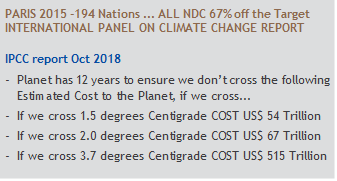
Why should both Corporate and National Strategy focus on Climate
Emergency challenges?
The answer is clearly captured in the above slide which gives us the reality in terms of impact to both national and
business Supply Chains as sea levels rise and wipe them out. The fact is 98% of the planet is now affected by the Climate emergency, which leaves no nation or business that is isolated from the vulnerability of debilitating impacts.
Is there any impact of deforestation to the businesses and economy?
Every business Supply Chain will be affected in two ways if we continue with the deforestation we have so far inflicted on the planet where by 2018 we have wiped out over 70% of all our virgin forest cover /rain forests. This has also led to the destruction of over 60% of the planets fauna and flora species.
- It will seriously jeaprdize agriculture and raw material regeneration.
- It will impact the rain cycle to create massive droughts and water scarcity.
In the recent past we have seen South Africa and India declaring water crises in many of their key cities. Almost every nation will be affected by extream weather incidents of drought, extream teperatures and flooding as demonstrated in the slide below and if one studies it closely flooding, excessive rain fall and hurricanes acocund for over 70%
of extreme weather incidents which will having a drastic impact on all global supply chains and livelihood.
Extreme Weather incidents 1995-2015
- EXTREME TEMPERATURES
- DROUGHT & FOREST FIRES
- HURRICANES & FLOODS
Percentage of occurrences of natural disasters by disaster type (1995-2015)
Flood Storm Earthquake
Extreme temperature Landslide
Drought Wildfire
Volcanic activity
India is the most polluted country in the world and 22 of 30 most
polluted cities in the world are in India according to the CNN. Due to that is there any impact to Sri Lanka?
As we know, pollution does not need a visa to travel abroad and enter a nation. The sea and atmosphere carry a nations pollution across the sky and ocean. Sri Lanka is already seeing the impact in our sea shore of massive amounts
of plastic pollution ending up in our sea shore. As India increases its coal energy plants the ‘polluted’ air will be in our nation. The real crises will be when India runs out of water (already by July 2019 over 40% India is drought affected and Chennai declared a water emergency). Sri Lanka will face a geopolitical security threat as India runs out of fresh water.
Kandy district tops the list in air pollution in Sri Lanka. Its air is
polluted three times more than the air in Colombo. Is there any mechanism in
Sri Lanka to measure the air Pollution?
Unfortunately it is clear that ‘Air Pollution’ levels are NOT REPORTED as is the case in most nations. Widespread scientific air pollution monitoring and reporting is urgently required and it is surprising that both deforestation and air pollution don’t seem to be prirotiy issues at a National sustainability strategy level with over 86% of Sri Lankas’ virgin forest cover wiped out and the recent plans put
forward by the Ministry of Power and Reneweable energy to add 10 New Coal power plants when the one plant we have is having unprecedented health risks confirms that the nation is ignoring this risk.
Could you suggest few strategies we Can Reduce Our Reliance on Fossil
Fuels?
The Sri Lankan Government made a commitment at the UN Climate Change conference in Paris in December 2015
- To achieve 60% of all energy requirments with Renewable energy by 2020
- To achieve 80% of all energy requirments with Renewable energy by 2030
The recent CEB /Energy ministry presented strategy is to do the exact opposite with over 80% of our energy to be sourced by polluting fossil fuels by 2037.
The strategy available to Sri Lanka is clear if its committed to following the sustianble path.
- Pursue sustainable Solar/Battery and Wind energy soultions
- Accelerate Electric transportation for both public and private sector.
The sad reality is though New technology solutions in terms of Solar/Battery solutions available with Tesla & BYD (China) are already mobilized and working in South Australia, Hawaai, Costa Rica, Barbados to name a few recent cases the Government of Sri Lanka have ignored them to pursue a fossil fuel driven strategy which require Sri Lanka to exit the Paris agreement.
Any National Sutainable Development strategy needs to focus on the following 4 UN Sustainable Devleopment Goals and drive forward to achieve them without compromising them as is the case with fossil fuel driven energy today.
| 12 CONSUMPTION RESPONSIBLE | 15 ON LAND |
The four Key UNSDG led strategy is clearly articulated and urgently required to be mobilized in Sri Lanka. For an Advanced Strategic National Sustainability to be created
and mobilized in Sri Lanka, we need Sustainability mind set leaders. This is a perquisite…unfortunateky sadly lacking in the Nation today.
European countries vowed to ban diesel and petrol cars by 2040. Norway has
pledged to ban petrol and diesel vehicles by 2025, and India by 2030. What is your view on this?
As mentioned earlier the key reason for Global warming acceleration is the burning of fossil fuels for energy and transportation. This was confirmed in the recent July 2019 report presented by the Scientific community led by Dr Nathan Stieger of the University of Bern. Therefore any Nation remotely commited to avoiding the Climate emergency MUST move away rapidly from Fossil fuel
driven energy solutions and transport. In Sri Lanka, we are completely off the mark by actually increasing the Fossil fuel
/Coal driven energy solutions.
These advanced thinking Nations are moving in the right direction and will need to target 100% renewable energy driven transportation and energy solutions by 2030-2040! In order to achieve the above two major policy decsions are needed to BAN the importation of ‘New’ petrol and diesel
driven vehicles with immediate effect and to set up rapid charging electric networks in each nation. Ideally duyt free incentives for all Electric vehicle imports is also needed.
None of the above is happening in Sri Lanka today.
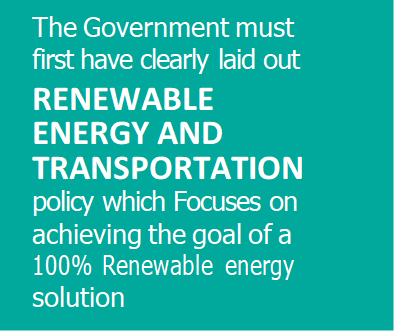
What is the role of government in renewable energy finance? Why would
the government invest in renewable energy?
The Government must first have clearly laid out RENEWABLE ENERGY AND TRANSPORTATION policy which Focuses on achieving the goal of a 100% Renewable energy solution.
Thereafter strategically tap into the latest Renewable energy technologies with globally available Sustainable enrgy supporting Climate Funding.
We should also work with the Chinese Asian Infrstructure Devleopment Bank, Asian Devleopment Bank, European Investment Bank to access funds to drive forward what is clearly the ONLY option we have committed to at the Paris Agreement.
As a key Nation in the China one belt , one road sea route we should learn from how Paksitan negotiatied with the Chinese Government to invest US$ 50 billion to completely modenrinze the nations energy sector from fossil fuels to Renewable energy. Sri Lanka has the bargaining power to do so.
Both physical and economic water shortages will threaten the very basis
of human life by 2015 according to the world resources institute water stress map.What are the strategies we can implement to overcome this problem?
I can categorially predict that the Key global conflicts from 2025 will almost certainly will be as a results of ‘Global water scarcity’.
The chart clearly demonstrates the crises faced by most Southern hemisphere nations where over 80% of the Worlds population resides.
While the World has only 3% of Fresh water for the needs of the every growing global popution, we have polluted over 70% of the fresh water and ground water available to mankind and ensured we jeapordize rain fall by wiping out over 70% of forest cover.
Could you briefly explain the Strategic Corporate Sustainability
imperatives for sustainable business?
The seven Imperatives identified are as follows:
The key strategies were already articulated in the above sections where we focused on 4 UNSDG’s. The Key focus SDG’s to drive the solution for the impending water crises are:
- Reforest with urgency with a manadatory 30% forest cover in every nation by 2030
- Harvest the Rain water and store with urgency for prolonged drought periods.
- De-pollute all the water ways and ground water
- Move to Prescision agriculture to save on the 70% of fresh water used in agriculture.
Page 16 www.cma-srilanka.org | Volume 07 – No. 4 – September 2019
How does strategic corporate sustainably impact to the triple
bottom line?
Strategic Corporate Sustiansbility is based on a business strategy that ensures ‘how money is made’ is through sustainable means. One key impact of it will strategically reduce both the impact and cost of all operations and increase the gross margin as a result.
Lower cost of energy, waste and water will immediately deliver savings.
CERTIFIED MANAGEMENT ACCOUNTANT
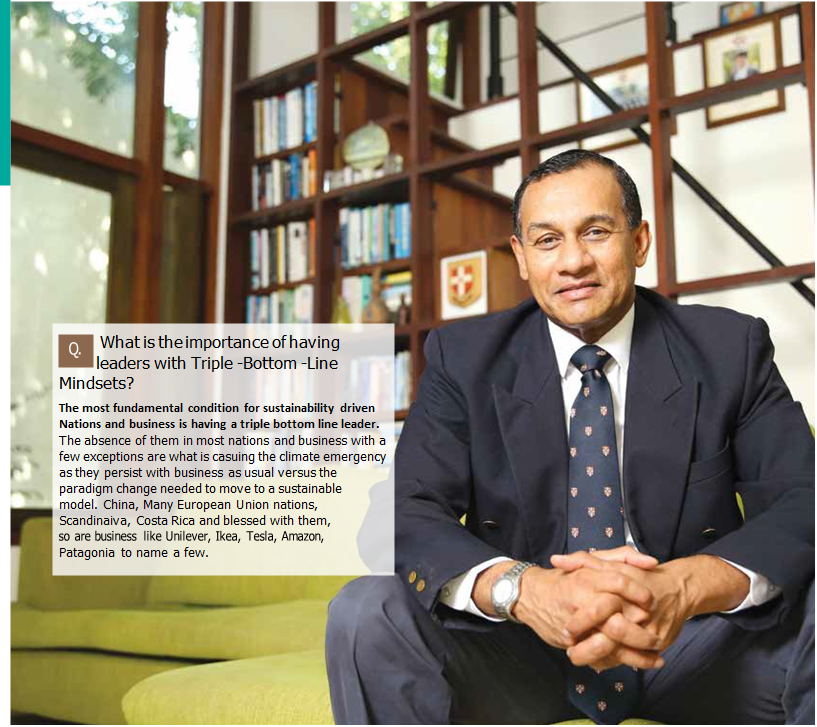
Do companies believe that sustainability -driven innovation
have the potential to bring business value to the organization?
Companies with a sustainability mind set leader not only believe but invest ONLY in Sustainability driven innovation. Tesla is an excellent example of this.
What is the importance of creating a sustainability culture in
the organization?
All Sustainbility mind set leaders will ensure that their organzations mainsteams sustainability/triple bottom line culture prevails in the organization as they know that they need every single member of the team and extended partners are of the same mind set to achieve its overall Corporate Strategy which is based on Strtageic Corporate sustainability.
A PERCEPTION OF THE ROLE OF A
FUTURE ACCOUNTANT
Abstract
CERTIFIED MANAGEMENT ACCOUNTANT
The purpose of this study is to analyze the perceptions of a future accountant’s role in business and to understand how education and the professional practice of accounting should change accordingly. This study comprised two hundred undergraduates from four different universities in Sri Lanka. The
areas of the study were leadership, ethics and professionalism. Exploratory and factor analysis were used to analyze the collected data. The findings of the study indicated that undergraduates perceive that accountants should have an above average level of professionalism, ethics and leadership. However, leadership has a negative relationship with ethics. The study suggests avenues for the profession to develop their image.
Introduction
Accountants will develop and sustain their personal and professional identities way beyond the definitions and images presented by professional associations and media. Failure to understand
this will affect the image of young professional accountants in the early years of their careers (Warren and Parker, 2009). A study by McDowall and Jackling in 2010 showed that Australian undergraduates perceived accounting
as rule-based and repetitive. This was a disturbing finding as this research
was done in an environment where the accounting curriculum has substantially changed within the last two decades.
The perception of accountants was however positive due to the promotional campaigns launched by professional accounting firms. A study conducted
by Jackling et al. revealed that ethical issues were likely to occur in accounting practices, which perceptions have been confirmed in current studies on the perception of accounting..
Dr. A. H. N. Kariyawasam Senior Lecturer, Department of Accounting, Faculty of Management Studies and Commerce, University of
Sri Jayewardenepura
It is important to study the perceptions of accounting in Sri Lanka in order, to understand how well the professional bodies could educate future accountants in keeping with what future managers want them to be. This will enable both professional and academic bodies to fashion [the ate their students better?] and to develop the accounting practice further. Accountants themselves will
be able to understand where their profession stands and what is expected of them from society. It is up to future accountants to shape their role in society and to change or develop the perceptions for the better.
A dynamic business environment requires accountants to change their mind set.
expected that through the findings of this study professional bodies will be able to change their curriculum accordingly so as to educate accountants to fit the needs of future businesses and to understand their future role. Professional and academic bodies will have to introduce extra-curricular activities designed
for their personality and leadership development. This research will also help to compare the roles of Sri Lankan accountants and those of other countries and how Sri Lankan accountants can fill the gap if they want to seek employment in other countries.
This paper consists of six sections. In the introduction the background and the aim of the study are explained. The available literature is discussed in the literature review. The methodology section explains the research approach, the sample, hypotheses, and variables. The data analysis section deals with the data analysis method and the results
section with the findings of the present study. The discussion section compares and contrasts the findings of the study with the available literature and the conclusion summarizes the findings and states the concluding remarks.
Literature Review
Perception of accountants According Joyce and Mun (2013), perceptions are intuitive first impressions, attributions and understandings relating to individuals and/or groups. This study focuses on the perceptions in respect of three aspects of a professional accountant in Sri Lanka, namely, leadership, ethical values and professionalism.
Leadership
Rehman and Naveed (2019) stated that leadership is the ability to motivate, influence and help others to contribute to a common goal. Leadership styles range from autocratic, participative, and laissez faire, according to Joyce and Mun, 2013, who explain leadership styles.
Autocratic leaders focus on control and management command. Financial controllers are traditionally expected to be highly rule-based, adopting an
autocratic leadership style. Participative leadership is based on team work and mutual exchange of ideas. Laissez faire leadership is a highly delegated approach that depends on the trust the leader places in his subordinates and with less interference.
In Joyce and Mun’s study, they state that, since management accountants are not bound by international financial
reporting standards as much as financial accountants, their role will extend
to planning, control and decision making functions, which require a certain amount of leadership. Further, management accountants have a duty to drive the organization through risk
mitigation and strategic planning, which involve risk analysis, risk management, internal control and maintenance.
Therefore, accountants should possess leadership qualities that enable them to lead organizations.
According to Deloo et al., 2011, the classic separation of “scorekeepers and business advisors” is slowly diminishing. Only business-oriented management accountants will be required in the future. They have also stated that even though scorekeeping activities are still
a prominent part of a management accountant’s day-to –day work, internal analysis and risk management also have become important in a management accountants’ work. Therefore, future
accountants are expected to contribute more through leadership than being
a mere scorekeeper. Management accountants will also witness a process of hybridization, where the accounting profession will be combined with another profession.
According to Craig and James (1993), International Financial Reporting Standards (IFRS) are modified to incorporate the dynamic information needs of organizations, industries and the public. Therefore, accountants in the profession should be able to embrace the change and be leaders of change to safeguard stakeholder interests. They should be transformational leaders
in the organization to better cater to the information requirements of stakeholders.
The accountant of the future is therefore required to have the above average leadership skills.
Ethics
As stated in Joyce and Mun’s study in 2013, Milton Friedman has stated that ethics maximizes the wealth of
shareholders. Therefore, an accountant’s ethical duty will be limited to adherence of regulations and providing information to enable shareholders to maximize their financial wealth. By adhering to these theories, an accountant will be only expected to monitor and control the efficiency of performance. However, this classical theory has been often critiqued for its exclusive focus on shareholders.
According to Pruzan (1998), accountants face ethical dilemmas just as any other professional. Ethical behavior cannot
be achieved purely through sound audit trails or recognized standards. There is an increasing need for ethical accounting and reporting to provide information
to external stakeholders and to protect corporate reputation. Value-based management will create productive organizational structures, systems of communication and measurements- evaluation reward systems, which can attract, hold and develop, intelligent, responsible, creative, independent and loyal employees. Therefore, accountants will be needed to adhere to value-based management so that ethical values will be expected from them.
Kranacher (2009) has stated that in order to create high quality reports, it is important that accountants hold values such as independence, accountability, integrity, and reliability. Being a profession, accounting requires its professionals to be ethical and maintain credibility through self-regulation.
This will ensure the exclusivity of the profession and social standards. A
rule-based system can be reactive to the environment, and will not be able to address all ethical issues fully. Therefore the accounting profession should be a moral community that is continuously engaged in ethical practices and makes its members understand the value of engaging in ethical practices.
Joyce and Mun in 2013 have found in their study that ethical values were negatively related to the role of accountants as leaders of change.
Students in Malaysia have perceived that engaging in ethical activities will be a hindrance to change. Love for money among accounting students was significantly related to unethical
behaviour. The above research shows that ethical values should be instilled at an early age as it takes time to develop. The negative perception on ethics contradicts the findings of e other studies mentioned previously.
Professionalism
A distinguished body that possesses a specific knowledge base and has the requisite expertise to further nurture
the development of the necessary skills [for the public?] will be recognized as a profession (Joyce and Mun, 2013).
Professions are also known for their integrity which is often a voluntary commitment through self-regulation.
Karanacher, 2009, has discussed whether accounting should be categorized as
an industry or as a profession. Since accountants are committed to holding specialized knowledge through extensive academic training and voluntarily involving increasing public interest, accounting can be categorized as a profession.
Traditionally accounting was perceived
as being limited to book keeping and primarily assumed administrative “bean counter” roles. According to Bloom and Myring, 2008, accountants are often depicted as negative and stereotypical. They also found that accountants should be more sensitive to culture and differences in behaviour and attitudes. The researchers found that there was a shortage of qualified accountants due to
the negative perception of the profession. According to Joyce and Mun, 2013,
the scandals of Enron and Worldcom in the USA and of Satyam in India have tarnished the credibility of the profession. To rebuild the reputation, accounting standards are moving from a rules- based approach to a
principles-based platform. The findings suggested that the sample selected for the study believed that accountants should demonstrate an above average level of professionalism. However,
the accounting profession has been stereotyped as boring and dull. To avoid this negative perception, Joyce and Mun have suggested that accountants should keep abreast of business developments and engage in meaningful CSR.
Methodology
Research approach
A quantitative study was carried out to seek the perceptions of future accountants, a deductive approach
for this research and a survey method to gather data from the sample with
a self-administered questionnaire. A similar method was adopted by Joyce and Mun, 2013 to analyze the perception of future accountants of Malaysian undergraduates. The questionnaire was in English to eliminate language barriers. The perceptions of future accountants were assumed to be measured by measuring their leadership, ethics and professionalism as mentioned above.
Variables
Joyce and Mun, 2013 chose leadership, ethics, and professionalism as variables to be measured so as to derive the perception of the role of a future accountant. Therefore, these variables were used in the Sri Lankan context as well. Indicators adopted for the above variables were as follows:
The reliability of the factors was tested using SPSS and Cronbach’s alpha resulting in 0.76 which is above the reliability threshold level of 0.7. These variables were used to discover the perceptions of a future accountant’s role through a five-point Likert scale.
Hypotheses
Based on the above variables, the following hypotheses were formulated. They hypotheses were tested through the collected data as the study follows a deductive approach:
H1-Future accountants would be expected to have a higher than average leadership score.
H2-Future accountants would be expected to have a higher than average score on ethical score.
H3-Future accountants would be expected to have a higher than average score on professionalism.
Population and sample
This study focused on seeking the perceptions about accountants of future managers, entrepreneurs and accountants, etc. The population
consisted of accounting undergraduates in Sri Lanka studying in local universities while considering the ease of data collection.
Data was collected from 200 accounting undergraduates chosen from, four different local universities based on convenience chosen at random to make sure the study was unbiased. A hardcopy questionnaire was distributed among the students as it was easier to administer and ensured a high response rate.
Participation in the study was voluntary and confidentiality was ensured.
Since it was a hardcopy questionnaire and the researcher was personally present at many of the data collection points, it was possible to collect 200 responses.
Data Collection
As mentioned earlier, a self-administered questionnaire was used to collect the data. The perceptions for each variable were collected through a five point Likert scale, 1=strongly disagree and
5= strongly agree. The questions were adapted from the study of Joyce and Mun, 2013.
Apart from the perception, demographic information was also collected from
the sample such as age, education level, and gender, etc. The collected data was [cleaned?] and manually entered into SPSS for analysis.
Analytical tools
The collected data was analyzed using SPSS version 25. Mean, median and mode tests were conducted to analyze the sample and its qualities. For analysis, Chronbach’s alpha, Bartlett’s test of spherecity, Regression, Standard Deviation, and Kaiser-Meyer-Olkin measure of sample adequacy were used.
These tests, inspired by the study of Joyce and Mun, 2013, were used to ascertain the generalized perception of future accountants.
Analysis
Descriptive statistics
The sample consisted of a majority (around 60%) of female students of the ages of 22-23, most of them following a professional course in accounting as well.
Factor analysis
Ethics, leadership and professionalism scored above 1 in Eigen values and therefore considered as valid factors. The KMO and Bartlett test score was 0.85 indicating suitability for factor analysis. Cronbach’s alpha value for the main study was 0.85 indicating a statistically reliable construct.
Professionalism was perceived to be more important for accountants than ethics and leadership as the means for professionalism was higher than that of the items in ethics and leadership.
Ethics had a negative relationship with leadership, as undergraduates who had ranked leadership highly marked low on ethics. However, it is not significant. Leadership and professionalism together have a significant influence on ethics.
Leadership has the highest explanatory power of 0.456 compared to the explanatory power of ethics of 0.078 and
0.231 for ethics.
Among the leadership qualities the highest mean was scored for personal attention. Honesty scored the highest in the ethics questions. Intelligence was deemed the most important quality of professionalism.
Discussion
The findings of this study will be useful to find what the businesses would want from their accountants in the future.
The respondents were generation Y,
who will be future business leaders. The undergraduate participants in the survey responded that they expect accountants to possess an above average level of leadership, ethics and professionalism.
This is an encouraging finding that helps to understand what qualities future accountants should possess.
Personally attending to financial matters is the most expected function of an accountant as leader, followed by recognizing and appreciating the efforts of others. This finding suggests that
an accountant should possess a more democratic or participative leadership style rather than an autocratic leadership style. It follows Joyce and Mun’s finding in 2013 that accountants’ leadership qualities are important. Deloo et. al’s
in 2011 predicted that accounting will face hybridization and accountants will have to work as business advisors. The findings of this study support the Deloo et. al’s finding that being a good communicator and being influential scored third and fourth places. Craig and James noted that accountants should be able to drive organizational change. The change element of this study has only scored a mean of 0.539 and gained 8th place in the ranking. However, the findings overall support the finding in the previous literature that accountants should possess above average leadership qualities.
Kranacher (2009) stated that accountants should possess values such as independence, accountability, integrity, and reliability and this study suggests that the highest perceived
ethical value of an accountant is honesty followed by trustworthiness. This follows Kranacher’s finding though the priority is different. Integrity has scored the lowest rank among the six ethical values. Pruzan (1998) arrived at a similar finding that accountants should show
value-based management and more ethical values. Ethical values have been ranked 5 by the respondents giving it lower priority compared to honesty and trustworthiness. Another interesting finding of this study was a negative relationship between leadership and ethical values, similar finding to Joyce and Mun (2013)’s finding. Students seem to think that ethical values will hinder good leadership qualities suggesting that students perceive ethical values have to be compromised in order to be a good leader who drives the organizational change. The result shows that extrinsic qualities are more valued than intrinsic qualities.
Professionalism is the second most important quality that an accountant should possess in the eyes of the undergraduates who participated
in this study. Being intelligent and knowledgeable are the two most important characteristics of an accountant as a professional. Bloom and Myring (2008) has stated that accountants should understand behavioral changes and cultural differences. Wisdom has been ranked below intelligence by Sri Lankan undergraduates. According to Joyce and Mun (2013), the reputation of accountants has declined due to
the Enron and Worldcom scandals. Adhering to professional standards has been ranked lowest in this study suggesting that Sri Lankan
undergraduates want accountants to use their skill more than blindly obeying the professional standards set by the
regulatory bodies. Probably this supports Deloo’s findings in 2011 as business oriented management accountants will be wanted by the organizations.
The findings of this study support most of the previous findings in the literature with minor deviations. All three factors
-leadership, ethics and professionalism- are important for future accountants.
Therefore, all three hypotheses are supported in this study.
Conclusion
According to the study, leadership and professionalism are expected to be instilled in the accountants to drive organizational change. Organizations will need to upgrade their training
programs so as to instill these values in accountants. Professional accountants will also need to assist their management by playing an instrumental role in risk management and also develop an ethical culture, without being limited to a passive role.
Accounting and business courses should be changed accordingly. Accounting professional institutes and academic bodies can research together and conduct frequent surveys so that future graduates will be better equipped to
face the changes in the environment. To increase professionalism and on- the-job leadership training, academics can be seconded for industrial training programs in banks, public accounting firms, manufacturing firms, etc.
Students should be encouraged to be critical about current issues across different business disciplines such
as marketing, operations, etc. Since accounting is multi faceted in nature this will ensure a more holistic approach and eliminate the perception of accountants as being dull and passive. Students can be encouraged to engage in peer discussions and to engage in rigorous research on ethics since it is not possible for rules to
cover all the loopholes in the accounting profession. Academics can act as mentors for students to sort out their ethical dilemmas.
Continuous Professional Development is a way to increase accountants’ professionalism. If accountants fail to display professionalism in their duties, it could affect the confidence level of shareholders and potential
investors. It is important that accounting practice maintain its ethical integrity and technical expertise as well as
professionalism in the public interest. As a profession is made up of individuals,
it is vital that the accounting profession and personal attributes are closely aligned.
Furthermore, business schools need to educate students to appreciate CSR. It needs to be included in the culture of business schools. This would promote greater application of how businesses and accounting disciplines can be combined to make a difference.
This research can be extended to accountants in practice and to different countries or could be done as a comparison between the perception
of accountants in practice and undergraduates.
References
- Bloom, R., & Myring, M. (2008). Charting the future of the accounting profession: Certified Public Accountant. The CPA Journal, 78(6), 65-67. Retrieved from http://ezproxy.uwl.ac.uk/
login?url=https://search.proquest.com/ docview/212236883?accountid=14769
- Craig, JamesL Jr., 1993, “A call for leadership: Certified Public
Accountant”, The CPA Journal, vol. 63, no. 7, pp. 16.
- Deloo, I., Verstegen, B., Swargamen, D., (2011) ‘Understanding the roles of management accountants’, European Business Review, 23(3), pp. 287-313 [Online]. Available at: https: // doi. org/10.1108/09555341111130263
(Accessed: 11th May, 2019).
- Jackling, B., Cooper, B., Leung, P., Dellaportas, S., (2007) ‘”Professional accounting bodies’ perceptions of ethical issues, causes of ethical failure and ethics education’, Managerial Auditing Journal, 22(9), pp. 928-944 [Online]. Available at:https://doi. org/10.1108/02686900710829426
(Accessed: 5th May, 2019).
Joyce K.H. Nga & Mun, S.W. 2013, “The perception of undergraduate students towards accountants and the role of accountants in driving organizational change: A case study of a Malaysian business school”, Education & Training, Vol. 55, No. 6,
www.cma-srilanka.org | Volume 07 -No. 4 – September 2019 Page 23
CERTIFIED MANAGEMENT ACCOUNTANT
Lalith Dhammika Mendis
FCA ACMA
Chief Executive Officer Helanta Communications (Pvt) Ltd
Fostering Quality Inclusive Education & Lifelong Learning to Drive Smart Inclusive Growth and Sustainable Development
Right to Education
The Universal Declaration of Human Rights adopted in 1948 recognizes education as a human right. Its Article 26 states, “Everyone has the right to education”. Although it is not a legally binding statement, it is globally accepted as a fundamental human right. Since its adoption, the right to education has been reaffirmed in numerous human rights treaties and declarations of the United Nations.
Sri Lankan Perspective Public spending on education as a percentage of GDP in Sri Lanka has been declining over the last four decades.
The education budget at 3.98% of GDP in 1967 declined to a modest 1.7% by 2012, despite a population increase from a little over 10 million in 1967 to over
20 million in 2012, a two-fold or 100% increase.
The end of an almost 30-year ethnic conflict in 2009 along with a so-called peace dividend was expected to lay the foundation for a revolutionary new beginning of socio-economic prosperity for the nation. Most of the socio- economic ills experienced during the period prior to 2009 were attributed to the ethnic conflict on the basis that it was drastically draining state coffers whilst negating any prospects of economic advancement. With the conflict becoming a thing of the past and peace restored, the economic whiz kids of successive political regimes set their eyes on making Sri Lanka the miracle of Asia. In economic terms, Sri Lanka was now aiming to become an “Upper Middle Income Nation”.
Inclusive Growth
Inclusive growth is a strategy designed to ensure the equitable sharing of economic benefits among all segments of society. It is a long-term perspective and entailing an approach whereby both microeconomic and macroeconomic determinants are aligned to the achievement of shared economic prosperity. It is ofcourse of fundamental
importance that detrimental externalities such as corruption are tackled to
ensure sustainable shared growth. In an inclusive growth approach, the pace and style of growth are interwoven because a rapid pace of growth is unarguably necessary for a speedy alleviation of poverty, while a broad-based pattern
of growth spanning all sectors of the economy and encompassing productive manpower ensures enduring shared growth in the long run. Realignment of public spending, design and execution of appropriate policies, provision
of motivational incentives to spur productivity and boost export revenues, and appropriate allocation of resources across the state machinery based on prudent economic principles catering to the needs of a “Upper Middle Income Nation” are vital for bridging the gap between where we are today and where we aspire to be within the target time horizon. In the economic thrust towards the desired goal, a vibrant private sector is expected to play a pivotal role in driving growth.
Crucial role of Knowledge and Innovation in Inclusive Growth
Knowledge and innovation are essential ingredients of “Smart Inclusive Growth”, which entails flagship initiatives to link education, enterprise, research and innovation. Modernizing manpower/ labour and developing new skills
and competencies are a fundamental requirement in this process. Knowledge is a vital ingredient of success and is fast becoming the dominant source
of economic progress in the “New International Economic Order”. In today’s context, more than a country’s land mass, natural resources or the availability of costly raw materials, or any other resource for that matter, the qualitative aspects of human capital in
terms of education, training, culture, competitiveness, technical knowhow and knowledge etc. are gaining more relevance for determining the economic strength of a nation.
Fostering human capital, the vital determinant of Smart Inclusive Growth
Fostering human capital has thus become an essential pre-requisite for economic growth. In the modern world, knowledge commands economic value. Hence for social and economic development and the competitiveness of a nation in terms of skills, knowledge and competencies in a dynamic global environment, the quality of human capital is of unparalleled importance.
To achieve inclusive growth to join the elite club of ‘Upper Middle Income Nations” in the global arena, the private sector is expected to play a dynamic and pivotal role ably assisted by the public sector, which is expected to handle
the required investments in upgrading infrastructure on a win-win basis. In order to drive business enterprises to achieve above average performance on a sustainable basis, the crucial importance of well-trained, skilled, techno-savvy and competent manpower with the right attitudes and ethics cannot be overemphasized.
However, it appears that the body politic has yet to realize that one of the most important drivers of a country’s growth is quality and inclusive education, the key to producing the right human capital. Unskilled manpower is simply basic labour. Skilled, competent and techno savvy labour forms human capital that drives the GDP of a nation. In
order to be competitive, forward-looking and in step with current developments, people need wide ranging qualifications and a multitude of skills and technical capabilities in a variety of disciplines.
In the fast emerging postmodern social order, knowledge-based organizations are assuming an unprecedented level of importance. Knowledge-based
economies appreciate the economic value of human knowledge as never before.
Globally accepted modern economic norms are placing growing emphasis on the need to recognize the value of human resources as an important component
of organizational assets. It is becoming evident that skills, qualifications and knowhow that enhance the quality
of human capital play a defining role in transforming information into productive knowledge that helps to create sustainable economic value. Hence, human capital that generates economic value becomes a major contributor to a country’s economic growth.
Table 1: Average Years of Schooling & Economic Development
Source: ADB economics working paper series 225
Human capital is an intangible asset. It is not disclosed in the typical Balance Sheet of a company. It can be defined as the sum total of the economic value of workers’ experience and skills to engage in productive activities that would generate income and surpluses for a company.
The Human Capital Theory recognizes that all manpower or labor would not be equal as each individual worker in an organization would not generate the same economic value. Economic value generated by each individual worker would not be equal. Productive
The average number of years of schooling in the world was reported as 8.12 years, with males having 8.41 years of schooling and females 7.84 years.
A person in an industrialized country has the longest period of schooling of 10.81 years, while a person in sub- Saharan Africa has an average of only
5.43 years. This is indicative of the crucial role of education in driving economic growth through productive human capital. Industrialized countries possess larger masses of human capital compared to developing or poor countries and
thus have the productive capacity to transform factors of production such as land, capital etc. into goods and services of economic value.
Public Spending on Quality, Inclusive Education – A Vital Investment
In this context expenditure incurred on quality inclusive education, no
doubt, is equivalent to an investment in human capital development, the reason being that productive capacity could be improved by the quality of education which, in turn, leads to enhanced skills, knowledge and competitiveness. It will also help cultivate important attributes that make human capital productive, innovative and efficient in contributing to economic success. It is evident that investing in human capital would lead to tangible returns in terms of higher national income and faster economic growth. Education can also lead to less crime and generate healthy habits in individuals from an early stage of their lives to help them grow
as responsible citizens contributing to socio economic development.
Accordingly, public spending on
Education is a vital investment with sustainable long-term benefits rather than an annually recurring expenditure. It would serve as a catalyst to boost national income and create “Economic Efficiency” through optimal use of scarce economic resources, which is enabled by improvements in the quality of human skills.
Education and Human Capital
What is Education?
Education encompasses structured institutionalized learning from kindergarten to university. It includes acquiring skills, widening knowledge and enriching experience beyond the typical classroom environment, such as social interaction, affinity with nature, use of media and the internet and engaging in practical activities designed to acquire and enhance competencies and knowledge as well as stimulate and sharpen cognitive development.
What is Human Capital? Human Capital has been defined in many ways. The Organisation for Economic Cooperation and
Development (OECD) defines it as “the knowledge, skills, competencies and other attributes embodied in individuals or groups of individuals acquired during their life and used to produce goods, services or ideas in market circumstances”.
Human Capital could also be considered the accumulation of knowledge, habits, social and personality attributes, including creativity and skills embodied in the ability to perform tasks designed to produce economic value.
skills, technical abilities, creativity and innovation would correspond to the education, training, attitudes,
innovativeness and the level of skills of an individual worker.
Role of education in building Human Capital
Human Capital consists of four basic components; skills, capabilities, knowledge and personal attributes such as creativity, innovativeness, right attitude, commitment to achieve goals, loyalty, trustworthiness, integrity, etc. and therefore can be broadly classified into two main categories: Acquired Human Capital and Inborn Human Capital
Natural abilities and attributes help to differentiate and make a person unique. Such attributes cannot be acquired or transferred to others. For example, Albert Einstein’s creative thinking ability was unique to him. Similarly, one could become a good singer due to the natural gift of a melodious voice.
Acquired human capital, such as skills and capabilities could always be gained by individuals through training and engaging in various activities designed to enhance and sharpen skills and expand knowledge. An organization could improve human capital by investing in training programmes to develop specific job related skills.
Employees with superior skills, higher qualifications and capabilities are more highly remunerated than others, demonstrating the economic value of Human Capital.
Education enriches Human Capital and helps people make decisions for the benefit of society as a whole. A well- educated person could be expected to desist from socially objectionable and detrimental behavior and contribute
to the advancement of society. Education paves the way to reducing criminal behavior and cultivating socially responsible habits, mannerisms and ethical conduct leading to socio economic progress. The educated strata are better informed about continuously evolving global trends in socio-economic development and modern technology that contribute to changing every aspect of human existence. Education promotes wholesome habits, imparts knowledge, guides people to adopt healthy life styles and desist from morally objectionable and socially detrimental activities that would result in a substantial reduction of unproductive social costs that will enable public money to be diverted to worthy causes for the sustainable advancement of society.
For education to effectively build Human Capital, it has to be inclusive and non- discriminatory, enabling each layer of the social hierarchy to benefit from it. This will enable a mass creation of Human Capital that would lead to GDP growth.
Human Capital and Economic Growth
Robert Solow’s Neo Classical Theory of Economic Growth recognizes Education as a key determinant of economic growth. Although education per se was not a direct factor in his growth theory, his model provided the impetus for focusing on education on the basis that an educated population
representing human capital is necessary for technological innovation.
Nelson and Phelps explained “investment in humans”: workers needed education in order to use new technologies, thereby increasing total factor productivity and spurring economic growth. Later, endogenous growth models propounded by Lucas
(1988); Romer; Barro and Sala-i-Martin demonstrated that the accumulation of human capital through education and on-the-job training fosters economic
growth by improving labour productivity, promoting technological innovation and adaptation.
Human capital and economic growth are closely related: human capital can help to develop an economy through the knowledge and skills of people. It refers to the knowledge, skill sets and motivation of people which provide economic value. The concept of human capital means that everyone does not have the same skill sets or knowledge bases and the quality of work can
be improved by investing in people’s education.
Economic growth implies an increase in an economy’s ability, compared to past periods, to produce goods and services with greater economic value. It can be determined by measuring the change in the real gross domestic product (GDP) of a country. How Human Capital and Economic Growth are related and can
be measured by how much is invested in people’s education. For example, many governments offer higher education
free to people because they realize that the knowledge people gain through education helps develop an economy leading to economic growth. Workers with more education tend to have higher earnings, which then increases economic growth through additional spending.
Growth Prospects offered by Globalisation/ Global Value Chains
Globalization offers new and greater opportunities in the trade of goods and services to the developing world. Advancements in the ICT sector has enabled Global Value Chains to effect physical fragmentation of production processes by geographically dispersing the activities over preferred locations based on efficiency and low cost
considerations. This involves outsourcing as well as off-shoring. For a country to
be a part of a global/regional value chain it has to have infrastructure, education, rule of law and a good standard of health. Globalization has contributed to the development of the education systems in developing countries. We can clearly see that access to education has increased
in recent years as globalization offers a catalyst to jobs that require higher skills set. This demand has driven people to pursue higher levels of education and enhance their skills so as to enjoy better employment opportunities.
Common features of economic transformation influenced by Global Value Chains
- Export orientation focused on manufactured goods;
- Adaptation to ever “higher added- value” activity;
- High levels of investment and savings;
- Increases in rural productivity;
- Increases in income equality;
- Adaptation to the information paradigm;
- Availability of educated, low-paid, highly productive and disciplined labour;
- High levels of basic education and literacy for economic growth;
- Gender-equitable access;
- Equitable public education expenditure; and,
- Open, competitive and largely meritocratic education.
With G20 countries assuming greater economic weight in the Global Value Chain, Sri Lanka has to evolve forward looking policy measures to reform its education system to produce the high level skills required by a rapidly evolving knowledge economy. This will enable Sri Lanka to compete with regional players to secure opportunities at the higher levels of regional/value chains that offer greater economic benefits.
Strategic initiatives will be required to objectively study and implement necessary reforms in the present education system so that it will be
relevant to globally evolving trends and the opportunities offered by regional/ global value chains.
It is essential that reforms be introduced as early as from the kindergarten. Pre- school education plays a pivotal role
in the socialization of children from an early age. Primary and secondary education should provide inclusive
access to quality education that enables students to acquire essential basic skills and key competences relevant to a fast evolving knowledge economy marked by stiff competition. Methodologies should be established to ensure purpose- driven differentiation whereby children are categorized into sub groups based
on skills and abilities at Grade 11/12 pre-university level. Safeguards may be
required to avoid inequality, especially with regard to the disadvantaged. “The Knowledge Triangle”, the interaction between Education, Research and Innovation, is the key driver of
a knowledge-based society. “The Knowledge Triangle” is the key to the advancement of a knowledge-based economy and society.
Lifelong Learning
Lifelong learning is the process of continuing to learn new skills, enhance knowledge and acquire competencies on an ongoing basis throughout a person’s life. Successful people tend to have better reading habits, attend conventions and participate in various programmes that offer new insights that help them become more effective in their chosen fields.
There are three different kinds of lifelong education:
- Maintenance Learning – being up to date in your chosen field.
- Growth Learning – learning that adds novel knowledge and skills to those an individual already possesses.
- Shock Learning – learning that contradicts or reverses a piece of knowledge or understanding that an individual already has.
Lifelong Learning and the Challenges of an Aging Population
The Sri Lankan population is rapidly
ageing. Demographic statistics indicate that the Sri Lankan population in
2012 above the age of 60 years was 2.5 million, which was 12.5% of the total population. The number is projected to increase to 3.6 million or 16.7% of the total population by 2021. By 2041, it is expected to further increase to one- quarter of the population. This indicates that Sri Lanka’s Dependency Ratio
is on the rise. The challenges arising from an aging population are several. It causes a strain on public financing in the form of public funded pension
payments and allocation of funds to fulfil elderly health care and welfare needs. A shrinking labour force resulting from a short supply of young talent and a greater portion of the population in retirement will negatively affect national output. In Sri Lanka elderly people very often lead active lives and as a result many prefer to remain in the workforce
even after retirement. Therefore, the Government could explore the
possibility of implementing appropriate policy measures to retain people over 60 years in the active labour force. One of the options would be to redefine the age of retirement.
The Government could initiate policy measures to provide continuous learning
opportunities for senior citizens
to enable them to further widen their knowledge and sharpen their skills in productive activities. Those that remain active even after reaching the age of retirement would naturally enjoy better health and be psychologically strong to grapple with age-related issues. They could with enhanced skills and newly acquired capabilities enjoy better quality lifestyles and continue to support themselves without being a financial burden. There could even be industries and service sectors where senior citizen could still
provide constructive contributions based on their longstanding experience and continuous learning.
Conclusion
Sri Lanka could emulate the success story of countries that have risen (for example, Singapore) through building a progressive and forward looking educational system characterized by meritocracy and equal opportunities.
Education should be given pride of place as one of the key drivers of
smart inclusive growth and sustainable development.
Q. What are the first steps of a waste
management programme in our context?
Starting with waste profiling and identifying the exact content of waste (chemical/physical parameters) the internal approval process comprises of technical, environmental safety and health, and financial feasibility of meeting the waste disposal need.
Being the only party who has the license for [haz/hazardous] waste transport, storing and disposal we submit a comprehensive proposal to the customer.
Once the customer agrees with all the conditions we undertake the final disposal. During the delivery there is a verification process to check whether
the same approved material is actually delivered.
Once disposal is completed, we issue the thermal destruction certificate.
Q. What is Ecocycle Lanka and what is their main
role in conducting sound waste management practices and its commitment to sustainable development?
INSEE Ecocycle, the sustainable waste management arm of the country’s premier cement manufacturer INSEE Cement, provides sustainable waste management solutions that would make a significant difference from a national perspective. INSEE Ecocycle has been in the waste management industry for almost 16 years sharing its expertise knowledge, globally accepted technologies and management commitment as the most preferred waste management service provider in the country.
INSEE Ecocycle is the only comprehensive industrial waste management solutions provider in Sri Lanka with an annual capacity of
100,000 MT providing environmentally friendly industrial solutions to public and private institutions especially
for managing hazardous waste. We have currently invested Rs. 1.3 bn to provide solutions for 700 industries covering government, multinational and other local conglomerates.
With the current expansion, the company will make a greater contribution to national waste management, with the world-class resources of its parent company INSEE Ecocyclye in Thailand specializing
in industrial solutions in the region. The newly added service, the “INSEE Ecocycle Environment Solutions” arm includes services such as laboratory services, training and consultancy,
industrial cleaning, specialized logistics service environmental remediation, emergency response services, e-waste disposal, etc.
Q. What is their main operation hub and
what kind of facilities do they provide?
The main operation hub is the Katunayake pre- processing facility located at KEPZ,
laboratory services for waste analysis and specialized logistics for transporting and storing waste.
Q. What kind of technology is currently
used at Ecocycle Lanka?
Co-processing
Q. What is the difference between co-processing
and pre-processing?
Co-processing
Co- processing is a unique industrial process offered for the proper management of industrial waste through thermal destruction. It is a combination of the two processes of clinker manufacturing and industrial waste disposal, both carried out in the same environment as a single combined operation without adverse effects on each other.
Pre-Processing
We can’t dispose of all the waste as it is using a cement kiln. We must do some chemical and physical treatment to wastes prior to final disposal through co-processing. This is called the Pre- processing operation and it is done at our Katunayake pre-processing facility.
Q. What’s the difference between “co-
processing of waste in cement kiln” and “incineration”?
Co-processing is a globally accepted sustainable waste management technique which is also considered
a thermal treatment method and it completely destroys the waste
material. Energy generated for cement manufacturing is used to destroy
the waste with suitable resource utilization.
Incineration is also a thermal waste treatment process that converts the waste material into ash, flue gas and heat. It has a low temperature
compared to co- processing and the waste materials are not destroyed but the final residue is disposed of
properly. Additional energy is need for the system to destroy waste materials.
Do your preprocessing and coprocessing
facilities follow the regulatory technical standards and license?
Pre- Processing Facility
- Central Environment Authority schedule waste management licence,
- Central Environment Authority environmental protection licence, and
- Katunayake Export Processing Zone
-BOI environmental protection licence.
Co-processing Facility
- Central Environment Authority scheduled waste management licence,
What are the environmental
benefits of co-processing, co-processing to companies and co-processing to communities?
For the environment:
- Lowers CO2 intensity from facilities that use co- processed waste as fuel,
- Reduces CO2 emissions from burning waste which cannot be recycled,
- Reduces methane from landfills, and
- Conserves natural resources.
For Companies:
- Ensures complete thermal destruction of waste, and
- Reduces liability and risk to corporate reputation, enables
Is your company involved in e waste
disposal?
Yes, we provide environmentally friendly disposal solutions for e- waste. We assure zero footprint.
We are the first to introduce special disposal solutions for printer toner cartridges.
What is Insee’s contribution to
reducing the co2 footprint?
Following the saved CO2 footprint from the beginning and responsibly disposing of waste materials.
Waste vol Co-processed in Mts
- Provincial Environment Authority scheduled waste management licence,
- Central Environment Authority environmental protection licence, and
- Provincial Environment Authority environmental protection licence.
enhanced your regulatory compliance.
For Communities:
- Reduces the amount of raw waste going to open dumps,
- Conserves energy sources for the future, generations, and
- Creates job opportunities.
CO2 saving in Mts
2003-2006 2007-2010
322,367
2011-2014 2015-2018
Q. INSEE Ecocycle provides environmental
solutions to Sri Lanka’s municipal solid waste crisis through public private partnership. What is your relationship with the government and environment- related regulators such as
the Central Environmental Authority?
While island-wide Municipal Councils are struggling with challenges associated with waste disposal and recycling, INSEE Ecocycle, the waste management arm of INSEE Cement, has spearheaded a well-structured Public-Private Partnership (PPP) for Municipal Solid Waste management in co-processing “segregated non- recyclable plastic, polythene waste
from MSW’ since 2012 in Gampaha and Kurunegala districts.
As a pioneering initiative, the partnership has successfully demonstrated how the combined strengths of proactive private entities, the Central Environmental Authority,
Q. Insee Cement has won the National Green
Awards in Sri Lanka several times and adheres to eco- friendly waste management practices maintained by Insee Ecocycle. What can you say about this?
Bureau (PNB) and National Dangerous Drugs Control Board (NDDCB) to responsibly dispose of 928 kg of waste cocaine hydrochloride through cement kiln co-processing for the first time in Sri Lanka.
Q. How many corporates including government
institutions are closely working with Insee Ecocycle on industrial waste disposal?
About 700 + corporates work with us -mainly corporate, multinational companies, local conglomerates and government organizations.
Q. Does Insee Ecocycle assist in disposing
of chemical waste from laboratories?
Yes, Ecocycle accepts chemical waste from laboratories and we have already recommended a solution to the Registrar of Pesticides, University of Peradeniya, etc.


CERTIFIED MANAGEMENT ACCOUNTANT
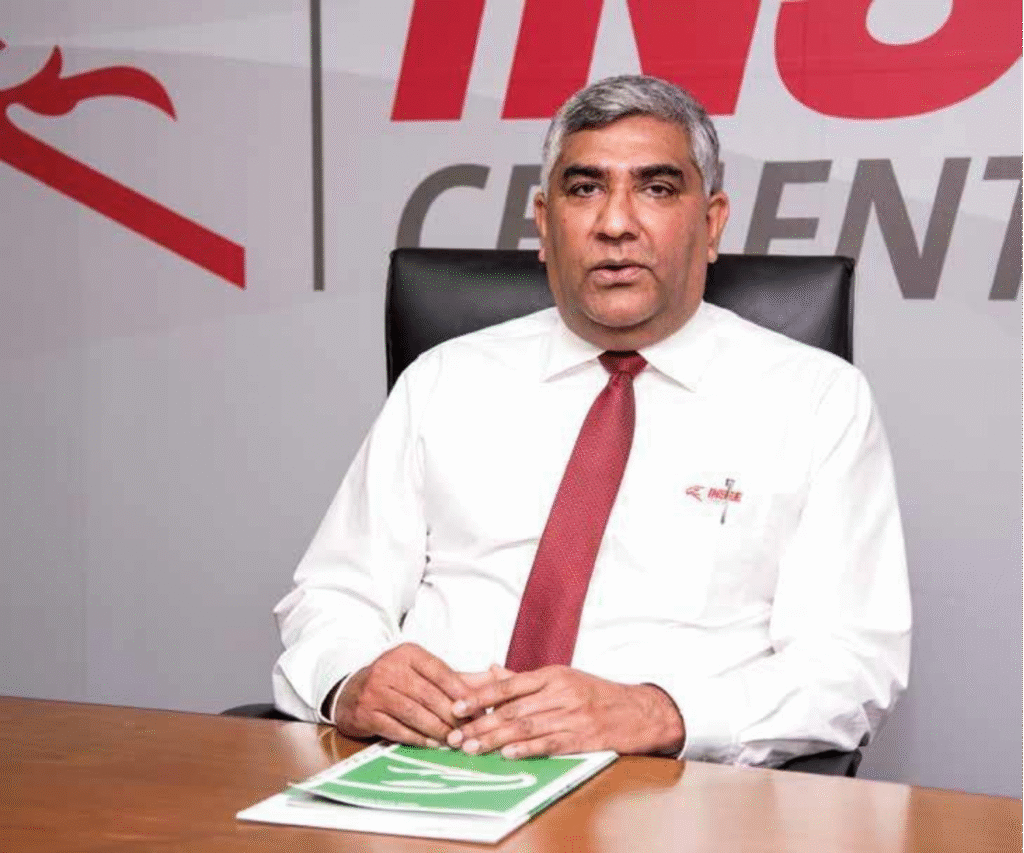
How do you educate the younger generation on sustainability concepts and waste management?
Does Insee conduct awareness programmes on sustainability concepts and waste management in Sri Lankan schools?
INSEE is continuously working with schools [which are in its facilities communities?]
INSEE Ecocycle has signed an MOU with the University of Sri Jayewardenepura and Sri Lanka Association of Australia Awards Alumni (SLAAAA) on institutional collaboration to conduct awareness programmes on sustainability concepts and waste management in Sri Lankan schools
How does the INSEE family support the national drugs prevention programme?
It helped In cocaine disposal on two occasions.
Page 34 www.cma-srilanka.org | Volume 07 – No. 4 – September 2019
CERTIFIED MANAGEMENT ACCOUNTANT
A PERSPECTIVE ON BUILDING A SUSTAINABLE
ANTI-MONEY LAUNDERING
ENVIRONMENT AMIDST EVOLVING TECHNOLOGIES OF
CRYPTO ASSETS AND BLOCKCHAIN
- Introduction
Money Laundering is a global threat requiring the urgent attention of policy makers to protect financial systems from criminals. Rapid developments in financial innovation, information technology and communication processes have paved the way for money to move anywhere in the world with speed and ease, making the task of combating money laundering an even more daunting task. The United Nation’s Office on Drugs and Crime (UNODC) (2019) estimates that the
amount of money laundered globally in a particular year ranges from around
2-5% of global GDP or US$ 800 billion to US$ 2 trillion in current US dollar terms. McDowell (2001) defines money laundering as the act of channeling illicit funds through outside financial
channels in order to make funds appear legitimate. According to FATF(2019), money laundering is the processing
of criminal proceeds to disguise their illegal origin. The main motive of money laundering is to disguise the source of assets in order to avoid detection of the illegal activity from which the assets were derived. The intent of the criminal is to conceal, safeguard and use the illicit proceeds at a future date when the “heat” has sufficiently died down in searching for the money and the criminal. This
is summarized by UNODC(2019)
as criminals trying to launder money to hide evidence of the money trail
of their crimes. Further, money itself is vulnerable to seizure and has to be protected .
A typical money laundering cycle consists of a dynamic three-stage process: placement, layering and integration, regardless of who uses the apparatus
of money laundering. At the first stage, criminals enter the “dirty money” in the
financial system. At the second stage, they perform a series of transactions to conceal the origin of the funds, which include breaking the funds into much less conspicuous levels and layering so that the lesser amounts are not easy to
Figure-1: A Typical Money Laundering Process
detect. At the final stage of integration, funds which were broken up into smaller portions are integrated into the economy appearing as legitimately earned/ speculated/invested funds. This process is further clarified in Figure-1.
that needs the relevant jurisdictions to strengthen their domestic legal frameworks and take other measures to safeguard financial systems and economies from criminals.
This, however, is not an easy process due to the continuous innovations in financial technology, the rapid
evolution of Information Technology such as block chain and internet- based payment methods like crypto
currencies. Although these are relatively new areas, crypto currencies enabled
by block chain technology are easily accessible to criminal elements as a tool in the process of covering up the illicit origins of criminal proceeds. For example, McCahill (2019) reports that a terrorist organisation had converted cryptocurrency into physical currency shortly before carrying out the deadly Easter Sunday suicide attacks at several
locations in Sri Lanka on April 21, 2019. While this remains the background to this paper, the discussion will address the implications of evolved technology, especially Blockchain technology and cryptocurrencies, on criminal elements relating to money laundering.
Cryptocurrencies are becoming popular, creating a new payment platform which challenges traditional banking. A crypto asset has come a long way since its inception as an alternate form of currency or payment that did not require third party intervention. Nakamoto(2008) first introduced cryptocurrencies by
publishing an email in the Cryptography Mailing List, stating simply, “I’ve been working on a new electronic cash system that’s fully peer-to-peer, with no trusted third party”. He published a white paper outlining a peer-to-peer electronic cash system called “Bitcoin”. Even though
the crypto asset system appears to be complex, its operational mechanism is easy to understand. The main purpose of developing an electronic cash system was to allow online payments from one party to another without going through a financial institution. This electronic cash system will eliminate the costs
of transactions such as commissions and fees and the payments would be authorized through a system of digital signatures. The need for having a bank
parties involved would be obviated by establishing a network system. So, the trust to be established by the presence of a financial institution would be built through cryptographic proof.
Transactions are grouped into blocks and time stamped for easy verification of payments. Double payments are prevented through timestamping. Peers are organized as networks to avoid
third-party intervention and facilities are provided to combine or split payments.
An electronic coin, the primary unit of a transaction, is a chain of digital signatures. Each owner possesses two keys, a public key that can be seen by
others and a private key known only to him, generated by the computer system. Coins are transferred by the present owner to another by signing a hash,
an authentication that it is a genuine transfer from the previous owner and the public key of the next owner while simultaneously authorizing the transfer by signing his private key. The coins are stored in a digital wallet and the use of the public key and private key will enable the new owner to open his wallet and release the coins stored therein. Thus,
there is a chain of all transfers made with all transfers connected through a node,
a point at which two digital signatures
meet. The new owner can verify the authenticity of the transfer by looking into the public keys of all the previous
transfers. The work of Nakamoto (2008) is now known as Blockchain technology and depicted as follows:
The development of crypto currencies challenges the status quo of well- established financial institutions with the additional risk of emerging technology being used for illegal activities. The
Basel Committee (2018) states that while the crypto-asset market remains small relative to that of the global financial system, and banks currently have minimal direct exposure, the continued growth of crypto-asset trading platforms and new commercial products related to crypto-assets have the potential to raise financial stability concerns and increase risks faced by banks. In this context, recent and expected future developments of crypto assets will be important to strengthen the efforts of a jurisdiction’s
anti-money laundering laws to counter the financing of terrorism.
- Using crypto assets to cleanse illicit proceeds of crime
Although this is a relatively new area, many have delved into the detailed incidents of crypto assets being used by criminals as a process of covering up the illicit origins of the proceeds of crime (McCahill, 2019). A number of high profile investigations and prosecutions suggest Bitcoin to be the most sought after choice of currency for criminals (Malik, 2018). Bitcoin has been used in the buying and selling of illegal drugs, purchasing internet malware bots and
spying tools in dark web sites, laundering funds through online games and funding acts of terrorism.
Bitcoin’s popularity has increased its mining activity and circulation. The Bitcoin blockchain is a public ledger of all
Bitcoin transactions that have been executed. It is constantly growing as ‘completed’ blocks are added to it with a new set of recordings. The blocks are added to the blockchain in a linear, chronological order. Thus far, the number of Bitcoins has been growing
since the creation of this virtual currency in 2009 reaching approximately 17.12 million in June 2018. A typical money

laundering process would have a money laundering cycle, which involves placement, layering and integration. A
typical process using crypto assets would also follow these three steps as follows:
Step 1: Placement
The criminal purchases a basic crypto asset at a digital exchange using illicit proceeds (cash, digital currency, or debit/ credit/ATM card). Crypto asset exchange service providers are usually obligated by law to conduct customer due diligence measures. These digital exchanges
would often be accessed by straw men working and posing as a front for known criminals and criminal networks. A straw man /men may provide a degree of anonymity to the criminals and criminal networks. Anonymity is extended by using Virtual Private Networks (VPN), anonymous e-wallets and blockchain enabled smartphones. At the placement stage, once the initial identification, verification and KYC is done, the digital
exchange will transact fiat currency or bank transfers to place funds to
purchase crypto assets, which are known as primary coins. Then, the primary coins will be used to obtain alt-coins at an advanced exchange. Alt-coins have advanced features such as high level anonymity to the user (Antonopoulos, 2018). Criminals try to obfuscate the primary coins to hide the trail in order to throw anyone tracing the proceeds
of crime. The tactics most often used are known as tumbling or mixing. This process involves a mixing service such as Bitmixer or Helix. These mixers swap the primary coin’s addresses to temporary digital wallet addresses to fool the blockchain and break audit and investigative trails. Criminals use strategies such as false addresses of recipients, re-routing of transactions to backup addresses, thus disrupting the audit ledgers in the process. Mixed
primary coins are now transferred to an advanced digital exchange to purchase
privacy coins that use higher level encryption and complex private key encryptions.
Step 2: Layering or privacy coins The would be launderer layers the multiple privacy coins and exchanges digital addresses to sever the audit trail – this is preparing the illicit funds to be integrated back to society as legitimate funds.
Step 3: Integration of the layered cryptoassets
Several options are available to the launderer:
Burst-out integration: Privacy coin holdings are converted/exchanged to primary crypto assets, which are
converted, in turn, to fiat currency or electronically transferred to a bank account or used for consumption or investment- related consumption such as real estate purchases, etc.
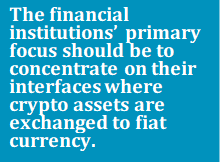
Blockchain tech could be used to
track the movement of goods, origin, quantity and many more factors and could be accessed at multiple points by different categories of users (managers, transport, delivery personnel, etc.) updating the information as the supply chain moves forward. Coupled with the Smart Contracts concept, Blockchain
is also utilised in quality assurance processes. This would enable carrying out of inspections and audits in cases of irregularities with updating and access from multiple points.
Blockchain technology can also be used in accounting. Because multiple users work as nodes checking and verifying the data within the accounts human error
is minimized, leaving an audit trail for future backtracking purposes.
- Conclusion
This paper was prepared to explain the implications of crypto assets in an evolving digital banking environment where the strengthening of the AML/ CFT regime of a country is a pre-
requisite for strengthening financial system stability. This paper concludes with suggestions on how to mitigate/ combat crypto asset-related money laundering threats. The primary focus of the combatants would be to strengthen financial institutions. The financial institutions’ primary focus should
be to concentrate on their interfaces where crypto assets are exchanged to fiat currency. The identity of the
transferor / straw man (men) could be the first link in establishing the illicit transaction. A risk-based approach has to be adopted focusing more on cash intensive operations and customers than on frequent cash transactions, digital currency exchanges, third party
transactions and occasional transactions. The most vulnerable or high risk areas may include recurring international
wire transfers, unknown or unverified customer inflows and outflows in large amounts, legal persons or entities engaging in digital modes of transfers and crypto assets, transactions which are structured and micro-structured to evade record keeping, similar transactions in multiples or series of transactions, rapid flow through of funds and transactions directed towards financial hubs or
digital money laundering hubs (such as Russia, Venezuela, Lebanon, Iran, DPRK, Ukraine, Turkey and Paraguay) especially where country borders are close to
areas of conflict, terrorist activities and similar conduct. Transaction monitoring mechanisms and developing in-house guidelines, policies and procedures
are vital to strengthen the AML/ CFT regime of financial institutions.
Further, financial institutions can use the potential of blockchain technology to prevent identifying theft and crypt- related money laundering. Accordingly, the institutions have a larger role to play in terms of crypto associated technology. However, apart from the speculative trend in crypto assets, it
is important to note the technology involved, i.e., blockchain technology will be the way forward to promote 0 further efficiency in peer-to-peer transactions (Wijewardena, 2017). This technology, harnessed prudently, would transform the future of financial integration
to allow for better transparency and efficiency that would support the further development of the financial sector.
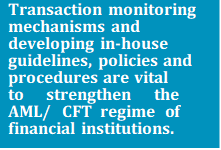
References
Agarwal, J. (2018, January 18). 8 Benefits of Blockchain to Industries Beyond Cryptocurrency. Entrepreneur: Asia Pacific .
Antonopoulos, A. M. (2018, August). Chapter 9. Alternative Chains, Currencies, and Applications. Retrieved from Safari -O’reilly: https://www. oreilly.com/library/view/mastering- bitcoin/9781491902639/ch09.html Basel Commitee. (2018). https:// www.newsbtc.com/2019/03/13/basel- committee-growth-of-bitcoin-is-a-bad- sign-for-global-banking-system/.
FATF. (2019). Financial Action Task
Force. Retrieved from What Is Money Laundering?: http://www.fatf-gafi.org/ faq/moneylaundering/
Malik, N. (2018, August 31). How Criminals And Terrorists Use Cryptocurrency and How To Stop It. Retrieved from Forbes- e magazine: https://www.forbes.com/sites/ nikitamalik/2018/08/31/how-criminals- and-terrorists-use-cryptocurrency-and- how-to-stop-it/#29cb359c3990 McCahill, E. (2019). ISIS funded Sri Lanka Easter bombings with Bitcoin donations. Retrieved from Mirror: https://www.mirror.co.uk/news/
world-news/isis-funded-sri-lanka- easter-14982949
McDowell, J. (2001). Consequences of Money Laundering and Financial Crime. Economic Perspectives, 6(2), 6-8.
Nakamoto , S. (2008). Bitcoin: A Peer-to-Peer Electronic Cash System. Retrieved from www.bitcoin.org.
UNODC. (2019). United Nations Office on Drugs and Crime. Retrieved from The Money-Laundering Cycle: https://www. unodc.org/unodc/en/money-laundering/ laundrycycle.html
Wijewardena, W. A. (2017). Banking Sector, Disruptive Technology and the Blockchain. Association of Professional Bankers: 29th Anniversary Convention, 9-22.
In my opinion, the main goal of
sustainability for an organization is at least to ensure that it performs from a holistic point of view
– basically generating shareholder value in an environmentally
What are the three pillars of sustainability?
Sustainability was defined by the Brundtland Commission as “meeti ng the needs of the present, without compromising the ability of future
generations to meet their own needs.” The subsequently conceived concept of the Triple Bottom Line enabled
corporates to identify a strategy on how to go about entrenching sustainability in their organizational processes.
The Triple Bottom Line performance became a metric of choice for organizations that wanted to achieve holistic performance by showing results on all three “bottom lines”.
What is sustainability management and why
is it important?
For the sustainability drive of a company to be sustainable it needs to be treated as a management process that broadly follows a “plan, do, check, act” (PDCA) cycle. Sustainability that is mostly centred solely on an initiative- driven approach may run the risk of investing too much resources on less significant and perceived impacts or too little of its resources on its actual significant impacts. Therefore, as with any other organizational function such as HR, Finance, etc, sustainability too needs to follow a logical approach to ensure that the sustainability drive in an organization remains relevant and value-adding to the organization’s internal and external stakeholders and the environment.
What are the benefits of sustainability?
If sustainability is implemented and integrated as a logical sequence of events culminating in relevant and topical sustainability initiatives, then the benefits can be immense. From the more obvious benefits such as risk mitigation, cost reduction, and efficiency gains, a company also stands to engage more closely with its stakeholders, identify new markets, target niche customers and develop new product lines. Such a logical approach to sustainability will also initiate new ideas and drive innovation within the organization.
What is the main goal of sustainability?
In my opinion, the main goal of sustainability for an organization is at least to ensure that it performs from a holistic point of view – basically generating shareholder value in
an environmentally and socially responsible manner while having a net positive impact on all its stakeholders. However, I believe that sustainability has to extend beyond compliance.
In the terminology of the Integrated Reporting Framework, an organization needs to actually add value to the natural capital, human capital and social capital it utilizes, while adding value to its financial and other capitals. It is only when organizations see sustainability as a value addition will
it also start reaping the benefits of innovation, new business and markets and also start creating shared value (CSV).
Why do we need sustainable managers
and what should their role be?
We need not only sustainability managers but also sustainability representatives in the boardroom similar to CFOs or CMOs. A sustainability manager’s and Chief Sustainability Officer’s role is to ensure that the company implements the various components of its
Sustainability Management Framework.
In the sustainability world, why is
“materiality assessment” important?
Materiality Assessments should be the start of the sustainability journey of any organization. The objective of Materiality Assessment is to identify the most pressing sustainability topics of the organization, prioritize those topics and then embark on
a strategy of mitigating the risks associated with those topics. Thus Materiality Assessment provides direction to a company’s sustainability strategy, drives its policies, its management approach and its choice of sustainability performance metrics, enables benchmarking and ultimately helps identify sustainability initiatives that address the most pressing sustainability needs. Conversely, an organization that dives a sustainability drive without identifying its material sustainability topics in a logical and scientific manner runs the risk of utilizing its limited resources on
feel-good initiatives and fads and also runs the risk of being seen as green- washing.
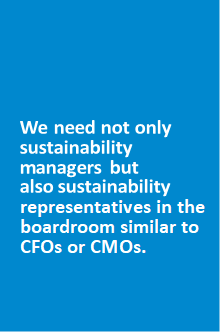
Should materiality assessment be
verified through a stakeholder engagement exercise and how often should we do so?
This is akin to asking a customer for feedback on a product or service.
Once an organization undertakes a materiality assessment, it would be prudent to identify whether the material topics the organization
identified are actually the same set of topics that its other stakeholders too consider important and significant.
Thus, stakeholder engagement acts as a validation of the material topics identified, and the output and learning of such stakeholder engagement should lead to the updating / changing the areas of sustainability topics
identified or changing the priority of the material topics identified.
Do companies standard operating
procedures (SOP) for sustainability data and business level processes?
A Standard Operating Procedure (SOP) will enable organizations to establish standardization and norms with regard to sustainability practices and non-financial data gathering across multiple operating locations, and also across multiple time periods. This will lead to like-with-like comparisons leading to easy identification of emerging threats and course corrective action and also clearly show the areas where improvements have been made. Additionally, SOPs will assist in undertaking internal and external sustainability assurance, as the required practice (or best practice) clearly identified and communicated across the organizational structure of the company.
’The majority of companies start off using easily accessible solutions like spreadsheets, but quickly realize the limitations of this approach. What can you say about this?
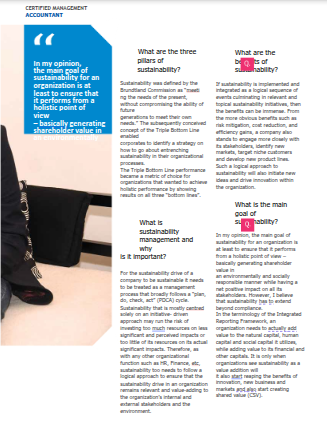
Why do we need sustainable managers
and what should their role be?
We need not only sustainability managers but also sustainability representatives in the boardroom similar to CFOs or CMOs. A sustainability manager’s and Chief Sustainability Officer’s role is to ensure that the company implements the various components of its
Sustainability Management Framework.
In the sustainability world, why is
“materiality assessment” important?
Materiality Assessments should be the start of the sustainability journey of any organization. The objective of Materiality Assessment is to identify the most pressing sustainability topics of the organization, prioritize those topics and then embark on
a strategy of mitigating the risks associated with those topics. Thus Materiality Assessment provides direction to a company’s sustainability strategy, drives its policies, its management approach and its choice of sustainability performance metrics, enables benchmarking and ultimately helps identify sustainability initiatives that address the most pressing sustainability needs. Conversely, an organization that dives a sustainability drive without identifying its material sustainability topics in a logical and scientific manner runs the risk of utilizing its limited resources on
feel-good initiatives and fads and also runs the risk of being seen as green- washing.
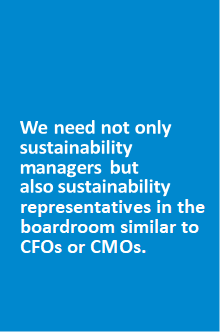
Should materiality assessment be
verified through a stakeholder engagement exercise and how often should we do so?
This is akin to asking a customer for feedback on a product or service.
Once an organization undertakes a materiality assessment, it would be prudent to identify whether the material topics the organization
identified are actually the same set of topics that its other stakeholders too consider important and significant.
Thus, stakeholder engagement acts as a validation of the material topics identified, and the output and learning of such stakeholder engagement should lead to the updating / changing the areas of sustainability topics
identified or changing the priority of the material topics identified.
Do companies standard operating
procedures (SOP) for sustainability data and business level processes?
A Standard Operating Procedure (SOP) will enable organizations to establish standardization and norms with regard to sustainability practices and non-financial data gathering across multiple operating locations, and also across multiple time periods. This will lead to like-with-like comparisons leading to easy identification of emerging threats and course corrective action and also clearly
show the areas where improvements
have been made. Additionally, SOPs will assist in undertaking internal and external sustainability assurance, as the required practice (or best practice) clearly identified and communicated across the organizational structure of the company.
’The majority of companies start
off using easily accessible solutions like spreadsheets, but quickly realize the limitations of this approach. What can you say about this?
In my opinion, this is an acceptable way to start. Many companies will not want to invest in IT systems at the very start of its sustainability journey without seeing the tangible benefits of integrating sustainability correctly. However, after the organization has convinced itself of the benefits of sound sustainability integration, it
CERTIFIED MANAGEMENT ACCOUNTANT
should definitely look to investing in sustainability IT systems, in order to ensure the timely, accurate and easy capture of data, and then carrying out speedy analytics, risk identification and reporting.
’Financial and
sustainability performances should be integrated to ensure proper presentation, which can be
understood by external stakeholders.” How far is this correct?
When sustainability is defined as triple bottom line performance, it becomes a given. An organization will need to show performance on all three pillars of sustainability which is the economic environment and social performance.
From the perspective of Integrated Reporting, an organization’s Natural, Manufactured, Intellectual, Human and Social and Relationship Capitals should be aligned and integrated with its Financial Capital, showing how each capital impacts other capitals through the organization’s operational processes.
What are sustainability management best practices
and their importance for companies?
Ultimately, a Sustainability Management framework needs to follow the management process of Plan, Do, Check and Act. Therefore, a good Sustainability Management framework should include issue identification through stakeholder engagement and materiality assessment, communication of the company’s stance and commitment towards material sustainability through its policy framework and SOPs, data collection, analysis and reporting mechanisms, establishing targets to ensure
a convergence of effort towards a single
sustainability agenda, undertaking relevant sustainability initiatives and monitoring their effectiveness and finally reporting the progress and future commitment back to the company stakeholders.
www.cma-srilanka.org | Volume 07 -No. 4 – September 2019 Page 43
Sustainability Assurance or Auditing is a process where the disclosures made by the organization
in its triple bottom line performance are audited by an independent third party for accuracy.
What are sustainability management
best practices and their importance for companies?
Ultimately, a Sustainability Management framework needs to follow the management process of Plan, Do, Check and Act. Therefore, a good Sustainability Management framework should include issue identification through stakeholder engagement and materiality assessment, communication of the company’s stance and commitment towards material sustainability
through its policy framework and SOPs,
data collection, analysis and reporting mechanisms, establishing targets
to ensure a convergence of effort towards a single sustainability agenda, undertaking relevant sustainability initiatives and monitoring their effectiveness and finally reporting the progress and future commitment back to the company stakeholders.
How can you be sustainable at work?
To entrench a culture of sustainability, an organization needs to follow a management process. Identifying stakeholder concerns and developing policies and procedures are all important aspects of the sustainability culture building process. Staff awareness, rewards and recognition and office-based sustainability initiatives can then only have the greatest impact. It is then that employee efforts start contributing to the organization’s overall sustainability vision.
What is sustainability auditing?
Sustainability Assurance or Auditing is a process where the disclosures made by the organization in its triple bottom line performance are audited by an independent third party for accuracy.
Sustainability assurance needs to be not only an audit of the numbers and data reported but importantly
should also include a process audit of the sustainability practices and data gathering mechanisms put in place by the organization. Thus, in my opinion, Sustainability Assurance undertaken based on standards such as ISAE3000 as well as AA1000 would result in greater value addition to the company rather than a Sustainability Assurance undertaken only based on a single standard.
How should a company assess
whether its sustainability drive is successful?
I believe that the answer to that has to arise from within the company itself by critically assessing whether its sustainability initiative and sustainability reporting provide value to all its significant stakeholders, society and environment, including its
internal stakeholders and shareholders. Ultimately, a sound sustainability drive will always have a return on investment be it through risk mitigation, cost reduction, or resolution of a concern
of a significant stakeholder of the company.
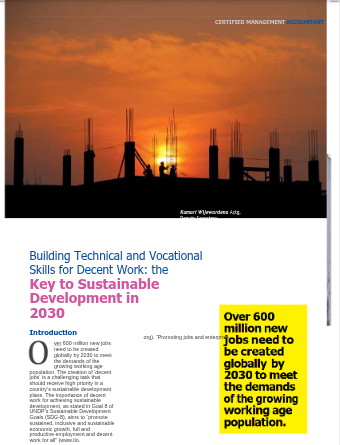
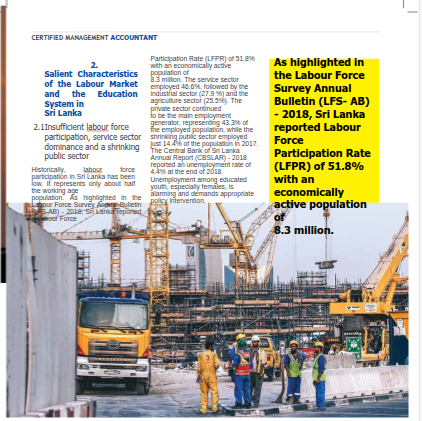
As per ‘Daily FT’, Sri Lanka’s NEET rate of 26.1 % in 2016 was slightly above the global average of 21.8 %. According to LFSAR 2017, NEET had dropped to 22.7
%. However, the female NEET rate of
30.2 %, when compared with the male rate of 14.8 % in 2017, remains a concern that requires accelerated policy attention.
- High Dropout Numbers
Each year, a significant number of youths leave the labour force due to reasons such as family commitments, disabilities or voluntarily. Table 1 shows the number of dropout students from 2013 to 2016. The number of student dropouts per annum from the educational system prior to reaching GCE Ordinary Level has been recently estimated at 32,000 (Perera, D., Daily FT).
Concerns of a diminishing trend in overseas employment of unskilled and housemaid categories
Target 8.8 of SDG-8 requires protecting labour rights and promoting safe and secure working environments for all workers, including migrant workers, in
Table 1: Dropout Students at G.C.E (O/L), G.C.E (A/L) and University Entrance
| Year | Dropout Students (in thousands) | Total | |||
| School Ordinary Level | All Ordinary Level | Advanced Level | University | ||
| 2012 | 155.5 | 217.4 | 88.8 | 120.6 | 426.8 |
| 2013 | 71.1 | 66.4 | 97.9 | 118.5 | 282.8 |
| 2014 | 70.1 | 51.1 | 97.8 | 123.9 | 272.8 |
| 2015 | 80.6 | 59.4 | 99.6 | 126.5 | 285.5 |
| 2016 | 74.4 | 35 | 97.7 | 129.9 | 262.6 |
| 2017 | 105.8 | 73 | 90.2 | Data not available | |
Source: Statistical Bulletin 2018, National Human Resources Development Council of Sri Lanka (NHRDC)
Even though the total dropout numbers generally show a decreasing trend, both School and Ordinary Level dropouts sharply increased from 2016 to 2017. The reasons for this increase in dropout numbers should be investigated to identify any shortcomings within the education system.
Figure 2: Comparison of expenditure on education and higher education (% of GDP)
challenges to the achievement of SDG
8.8. As highlighted in the CBSL Annual Report 2018, although unskilled labour departures declined by 15.3 % in 2018, unskilled and housemaid categories still represented 55.2 % of total departures in search of foreign employment. Concerns include sending under-aged women for employment through forged documents and human trafficking, as well as domestic issues that arise due
to unskilled migration, especially of women.
- Insufficient and unproductive expenditure on education, research & development
Some experts have highlighted education as a key hidden strategy for a country’s prosperity. The education system of Sri Lanka comprises three levels, namely, General, University and Vocational
Education. Even though Sri Lanka’s education budget is on par with that of some regional countries such as Pakistan and Bangladesh, it is relatively lower than in countries such as Vietnam, India and Nepal (Global Innovation Index -Annual Report – 2018). In 2018, Sri Lanka spent
1.93 % of its GDP on education, of which 0.44% was on higher education. Recurrent expenditure as a whole has increased over time and the proportion of capital expenditure on both education and higher education has been less
than that of recurrent expenditure from 2014 to 2018 (NHRDC-SB 2018, Pg.
30). It appears that the present level of expenditure on education, especially on vocational and technical education, needs to be adequately increased while rationalizing such expenses to achieve SDG-8.
Source: NHRDC Statistical Bulletin on Education – 2018
According to the ‘Sri Lanka Development Update’ of the World Bank (June 2018), Sri Lanka must encourage more innovation and entrepreneurship. It goes on to say that our investment in research and development (R&D) was only 0.16 % of GDP, lower than that of peers such as Vietnam (0.18 %), Thailand (0.25 %), and Malaysia (1.0 %).
- Is Sri Lanka where it should be in building technical and vocational skills to gener- atedecent work by 2030?
The characteristics of the labour market and education sector in Sri Lanka referred to in Section 2 highlight the need to review the effectiveness of existing measures to ensure that Sri Lanka is on the correct path to achieving SDG-8.
CERTIFIED MANAGEMENT ACCOUNTANT
3.2 The Global Innovation Index (GII): Sri Lanka Ranking
The GII, an index co-authored by Cornell University, INSEAD and the World Intellectual Property Organization, provides an annual ranking of countries by their capacity for and success in innovation (GII Annual Report – 2018). GII shows the innovation performance of 126 countries representing 90.8% of the world’s population and 96.3% of global GDP. Innovation being a prerequisite for promoting entrepreneurship, the GII ranking of Sri Lanka can be used as a benchmark for assessing Sri Lanka’s readiness for achieving the goals of SDG-8.
Table 2: Comparison of GII overall ranks and selected sub group ranks
- Contribution of the National Vocational Qualification (NVQ) Framework
The Tertiary and Vocational Education Commission (TVEC) implemented the NVQ framework in 2005 to achieve national and international recognition for qualifications, knowledge, skills and attitudes of Sri Lankans in an
increasingly globalized and competitive world. The system consists of seven NVQ levels awarded by the TVEC and University of Vocational Technology (UNIVOTEC). Certification up to diploma level courses is done by training institutions and accredited by the TVEC and. degree level certification by the UNIVOTEC.
As many as 696,500 students were registered and 493,300 students completed NVQ certificates during the period 2013-2016. This indicates a
dropout rate of approximately 30 %, the reasons for which need to be further analyzed and the potential for absorbing such dropouts as entrepreneurs or decent workers in the economy assessed.
Figure 3: Training Performance of TVEC Registered Training Institutions
Source: Global Innovation Index – 2018 Report
Sri Lanka was ranked 88th in 2018. Although on par with most of the regional economies, the pillar of Human Capital & Research where Sri Lanka is ranked 111 is an area that needs to be addressed and where government policy should play a crucial role to improve rankings to achieve the goals of SDG-8.
3.3 Transformation from informal sector to formal sector: an essential prerequisite
According to LFS- AR 2017, 58 % of the working population of Sri Lanka are employed in the informal sector which is subject to governance, integrity and disciplinary concerns. The magnitude of the informal sector is an impediment to generating decent work. Given below are a few examples of informal sector sub groups which need to be formalized in order to increase decent work in the form of workers and entrepreneurs.
- A recent news article revealed that 1 out of 9 workers in Sri Lanka is a three- wheeler driver. Although they provide an efficient and fair transport service, there is a social cost involved: the deterioration of road discipline. Measures should be taken to encourage youth to continue in formal secondary education that provides them an opportunity of transitioning to a formal career rather than working as a three-wheeler driver. Inculcating professionalism and increasing the occupancy time of three-wheeler operators should also be looked at. Measures adopted by the government such as providing free vocational training to three-wheeler drivers under the “From Three-wheel to Four-wheel” program implemented by the National Apprentice and Industrial Training Authority (NAITA) can have huge potential and promote entrepreneurial skills if successfully implemented and followed up.
- Well-regulated domestic housemaid services and day-care services have great potential for increasing decent employment and entrepreneurship. Jobs created by these services will be able to absorb educated women (who are at present engaged in domestic unpaid work) in the workforce, while providing safe and decent jobs for unskilled Sri Lankan women engaged in unsafe housemaid jobs overseas. As highlighted in the CBSL Annual Report 2018, it may also be a
solution for the social problems and social costs associated with the migration of
- Sri Lanka should also promote semi-skilled and skilled labour
migration to cater to growing global demands. Opportunities exist in the disciplines of nursing, medicine, IT, finance, accounting, management and engineering. By adopting international quality standards and maintaining professionalism in these fields, Sri Lanka will be able to gain an edge over regional competitors.
- Target 8.9 of SDG -8 aims to devise and implement policies to promote sustainable tourism that creates jobs and promotes local culture and products by 2030. As per LFS-AR, 2017, 66.2 % of the hospitality, shop
and related services sector (212, 221) represent the informal sector. Being a country with a strategic position
in the region and blessed with high biodiversity and historically famous for its hospitality, Sri Lanka can have an edge over other regional countries in the tourism sector.
However, strong recovery plans need to be implemented to fast track development of the tourism industry subsequent to the April 21, 2019 Easter Sunday terrorism attacks.
According to LFS-AR, 2017, 18 % (1.4 mn) of the working population were employed in informal skilled agriculture, forestry and fisheries in 2017. This indicates high potential for large scale domestic fish production capable of catering to the domestic as well as international market. Mega projects in this field can generate more formal jobs while encouraging entrepreneurship.
- Conclusion
Developing a tertiary and vocational education system capable of absorbing the active working age population in the labour force either as paid workers or as entrepreneurs is a long-felt need that requires the attention of policy makers and implementation agencies. Historically, Sri Lanka has sourced its labour requirements from within the
country. However, there is a recent trend among overseas investors to hire labourers from their own countries
for deployment in mega projects undertaken in Sri Lanka. This is partly due to the non-availability of the required skilled and unskilled labour in the domestic market. Even though certain programmes such as the NVQ
framework have been implemented from time to time, their progress appears to be insufficient. There are 148 state-owned vocational training centres in the country which enrol 160,000 students a year.
However, only 40,000 students complete the programmes. There is also no assurance of a job after graduation as the skills and competencies acquired by such graduates do not meet the requirements of the job market. The ineffectiveness
of some education policy measures is also evident in the high dropout rate prior to GCE/OL and afterwards (D. Perera, Daily FT). As highlighted by the Institute of Policy Studies, quality vocational education, apprenticeship, internship and mentoring programmes as well as government-led career
guidance initiatives established at school level aimed at advising and directing youth with a view to making education more market-oriented would definitely assist Sri Lanka in achieving the desired SDGs. Promoting professionalism
in all jobs, not just doctors, lawyers and accountants but also carpenters,
cleaners, caretakers, etc., is seen in many developed countries. Finally, it is time to quit being old-fashioned and searching for white collar jobs. The focus should be on market-oriented jobs that can make everyone better off!
References
Annual Report of the Central Bank of Sri Lanka – 2018 (Pgs. 134, 135)
Daily FT Thursday May 30, 2019, Article on ‘Restructuring the tertiary and vocational education sector in Sri Lanka’ published by the National Human Resources Development Council of Sri Lanka.
Daily FT Wednesday June 12, 2019, News Article on ‘NEET: an analysis of Sri Lanka’s disengaged youth’, published by the Institute of Policy Studies.
Global Innovation Index 2018 Report available at https://www. globalinnovationindex.org/gii-2018- report accessed in May 2019.
International Labour Organization Website, https://www.ilo.org/global/ topics/decent-work/lang–en/index. htm accessed 28.05.2018.
Labour Force Survey Annual Bulletin of 2018 published by the Department of Census and Statistics of Sri Lanka (Pg. 1, 2).
Labour Force Survey Annual Report of 2017 published by the Department of Census and Statistics of Sri Lanka (Pgs. 30, 37).
Operational Manual of NVQ Framework, 2009 published by the Tertiary and Vocational Education Commission (Pg.12)
Statistical Bulletin 2018, National Human Resources Development Council of Sri Lanka (NHRDC) (Pgs.13,18,19,30)
‘Sri Lanka Development Update’ of the World Bank (June 2018) (Pg. 37) available at https://openknowledge. worldbank.org/handle/10986/29927, accessed in June 2019.
Sumudu Vithanage MBM (Col), B.BA (Fin) Sp (Col); ACMA, APFA, AMIM, MAAT
Has Sri Lanka Progressed in Eradicating Poverty?
overty entails more than the lack of income and productive resources to ensure sustainable livelihoods. Its manifestations include hunger and malnutrition, limited access to education and other basic services,
social discrimination and exclusion as well as the lack of participation in decision-making. Various social groups bear disproportionate burdens of poverty.
Globally, more than 800 million people are still living on less than $1.25 a day; many lack access to adequate food, clean drinking water and sanitation. Rapid economic growth in countries like China and India has lifted millions out of poverty, but progress has been uneven. Women are disproportionately affected; they are more likely to live in poverty due to unequal access to paid work, education and property.
The Sustainable Development Goals (SDG) Framework affirms that poverty is the greatest global challenge to overcome for sustainable development. The first SDG aims to “end poverty in all its forms everywhere”. Its seven associated targets aim, inter alia, to eradicate extreme poverty for all people everywhere, reduce it at least by half the proportion of men, women and children of all ages living in poverty, and implement nationally appropriate social protection systems and measures for all, including [floors?], and by 2030 achieve substantial coverage of the poor and the vulnerable.4
The World Social Summit identified poverty eradication as an ethical, social, political and economic imperative of mankind and called on governments to address the root causes of poverty, provide basic needs for all and ensure that the poor have access
to productive resources, including credit, education and training. Recognizing the insufficient progress in poverty reduction, the 24th special session of the General Assembly devoted to the review of the Copenhagen commitments decided to set up targets to reduce the proportion of people living in extreme poverty by half by 2015. This target has been endorsed by the Millennium Summit as Millennium Development Goal 1. 5
Eradicating poverty in all its forms remains one of the greatest challenges facing humanity. While the number of people living in extreme poverty has dropped by more than half – from 1.9 billion in 1990 to 836 million in 2015 – too many people are still struggling to meet the most basic of human needs.
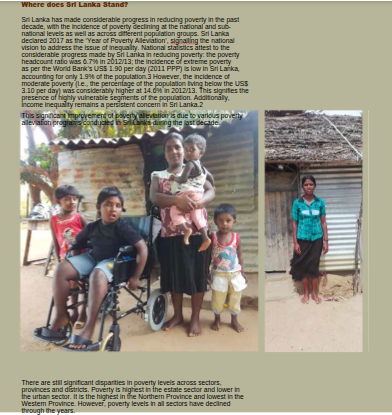
As shown in Figure 1, the proportion of the population below the national poverty line declined from 15.2% in 2006/07 to 6.7% in 2012/13. This decline in poverty is also reflected at sector and provincial levels. The poverty incidence trend in the rural sector that accounts for about 80% of the poor in the country has closely followed the national poverty trend while the poverty headcount index of the estate sector – which has historically been the sector with the highest incidence of poverty – declined remarkably from 32% to 8.8% during the past decade. The incidence of poverty in the urban sector has continued to remain well below the national average.
Figure 1
The existence of an effective social protection system is key to reducing poverty and vulnerability to poverty of a country’s population. Overall, about 34% of the Sri Lankan population received the benefits of social assistance programmes and social insurance programmes; they included households as indirect beneficiaries. Interestingly, nearly 45% of the elderly population (aged above 60 years) are covered by social protection, with a slightly higher coverage of elderly females (46.4% compared to 41.9% males).
Sri Lanka has made significant progress in ensuring access to basic services like health and education, electricity, safe drinking water and sanitation. The percentage of households with access to electricity
is 99.3 % (2016) while the proportion of households with access to safe drinking water is 88.8% (2016) and improved sanitation
facilities 91.7% (2016). The World Bank’s Global Financial Index data reports that 82.7% of the adults in Sri Lanka have access to financial institutions (or have access to bank accounts). This includes 83%
of women and nearly 80% of those belonging to the poorest 40%, denoting a remarkably higher level of financial access in Sri Lanka compared to other countries in South Asia. Sri Lanka’s Universal Free Education Policy and Universal Free Health Policy introduced in
the 1940s have played a pivotal role in ensuring access to education and health facilities to its population, particularly the poor and the vulnerable. The continuing expansion of economic activities and the decline in unemployment to less than 5% through the past seven years, along with the Government’s continuous funding of rural infrastructure development, have also contributed to boosting the income of the poor.
Gaps and Challenges
Despite Sri Lanka’s performance in poverty reduction over the past two decades, there are significant
geographical variations. The Poverty Headcount Index varies across districts from 0.9% in Colombo to 18.2% in Kilinochchi. While most of the districts with high poverty have a low population, significant “pockets of poverty” exist even in those districts where poverty levels have fallen.
Although the poor account for only 4.1% of the population, a considerable proportion of the vulnerable population is clustered just above the poverty line, facing the risk of slipping into poverty due to various shocks like natural disasters (e.g. floods, droughts and landslides). It is important to improve the resilience of the poor and the vulnerable, especially given the rising incidence of climate-related extreme events in the country affecting the lives and livelihoods of households.
Despite Sri Lanka’s progress in access to basic services like health and education, electricity, safe drinking water and sanitation, there are regional disparities with some districts and sectors (estate sector in particular) lagging far behind. Measures to improve access to basic services and utilities in these lagging regions are crucial for the eradication of poverty and achievement of SDGs.
Many social protection programmes have been implemented in Sri Lanka targeted at vulnerable segments of the population such as the poor, elderly, disabled, children, and women. Despite a multitude of programmes there are gaps in the current social protection system, including issues in targeting, inadequate benefits and lack of coordination among programmes that lead to high costs and duplication of beneficiaries.
In the non-governmental organizations (NGO) sector, the focus has been on elevating poverty among individuals by lending them a hand to reach sustainability. Some of the programmes initiated by NGOs involve identifying families in areas affected by war
or natural disasters. The chosen families are provided with start-up capital for small-scale businesses such
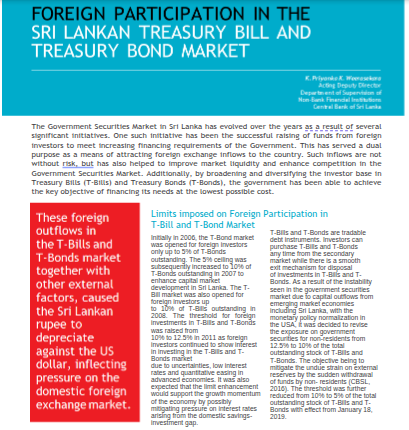
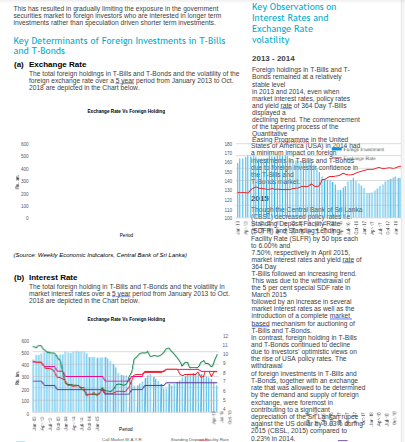
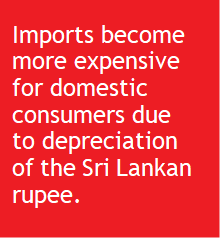
2016
The monetary policy stance of the CBSL was tightened with a view to curtail a possible rise in demand driven inflationary pressures through adoption of monetary policy measures, such as increase in policy rates i.e. SDFR and
SLFR by 50 bps each to 6.50% and 8.00%
respectively on February 19, 2016 and increase in the Statutory Reserve Ratio (SRR) by 1.50 percentage points to 7.50% from January, 16 2016. The CBSL again increased policy rates i.e. SDFR and SLFR to 7.00% and 8.50%, respectively, to be effective from July 28, 2016 (CBSL, 2016).
Responding to the restrictive monetary policy measures taken by the CBSL
by increasing key policy interest rates (SDFR and SLFR) by 100 bps in two steps during 2016, market interest rates adjusted upward and 364 Day T-Bills yields showed an increasing trend.
However, foreign holdings in T-Bills and T-Bonds were on a declining trend, mainly due to monetary policy normalization in 2016 in the USA that resulted in capital outflows from many emerging market economies, including Sri Lanka.
Other external factors such as the interest rate hike by the Federal Open Market Committee since 2016, unfavorable capital market conditions such as political and social instability within the economy and fierce competition from regional emerging counterparts also contributed to the declining trend in foreign holding in T-Bills and T-Bonds. These foreign outflows in the T-Bills and T-Bonds market together with other
external factors, caused the Sri Lankan rupee to depreciate against the US dollar, inflecting pressure on the domestic foreign exchange market. The Sri Lankan rupee depreciated by 3.83% against the US dollar during 2016, mainly caused by the repatriation of foreign investments held in T-Bills and T-Bonds parallel to the expectations of an interest rate hike by the Federal Reserve as well as the higher demand for foreign exchange
that emanated from import bills (CBSL, 2016).
2017
The monetary policy stance continued to be tightened in 2017 as well. Policy rates were increased by 25 bps each in March 2017 increasing the SDFR and SLFR to 7.25% and 8.75%, respectively.
Accordingly, market interest rates moved upward and the yield rate of 364 Day
T-Bills reached a peak in April 2017, reflecting a significant gap between policy rates and the yield rates on government securities (CBSL, 2017). However, the pressure on interest rates in the domestic market declined due to the International Sovereign Bonds issued in May 2017 amounting to US$ 1,500 Mn. The yield rate of 364 Day
T-Bills decreased by 127 bps by the end of 2017 compared to 2016. Further, net
inflows of foreign investments in T-Bills and T-Bonds amounting to US$ 440.6 Mn were recorded during 2017. These factors contributed the move towards a more market based exchange rate policy which resulted in the Sri Lankan rupee depreciating against the US dollar by 2% during 2017.
2018
Though the CBSL reduced the SLFR by 25 basis points to 8.50% while keeping the SDFR unchanged on 03.04.2018 to maintain a narrower policy rate corridor, tight monetary policy conditions
were maintained in line with other emerging market economies to address the challenges that exerted pressure
on the exchange rate. The continuous strengthening of the US dollar due to increase in policy interest rates by the Federal Reserve, adoption of a flexible exchange rate policy, withdrawal of foreign investments from the T-Bills and T-Bonds market, upward trend in international oil prices and an
uncertain global economic and political environment were some of the challenges faced. The Sri Lankan rupee depreciated against the US dollar by 12.9% during the year up to November,13 2018. To address the large and persistent liquidity deficit in the domestic money market, the CBSL decided to reduce the SRR
by 1.50 percentage points to 6% from November 16, 2018, and raised policy interest rates i.e. SDFR by 75 bps to 8.00% and SLFR by 50 bps to 9.00%, thereby narrowing the policy rate corridor to 100 bps on November 13, 2018.
Impact of unwinding of foreign investments in T-Bills and T-Bonds market
There are various factors such as volatility in the interest rate, inflation rate and exchange rate, political and economic stability, output or GDP, rate of economic growth, trade deficit,
fiscal deficit, level of debt, debt to GDP, unemployment, legal framework, uncertain and volatile global economic environment etc. that affect a foreign investor’s decision to invest in T-Bills and T-Bonds. It was observed that the sudden foreign outflows in the T-Bills and T-Bonds market is a key factor in determining the exchange rate, with the
pressure caused by outflows contributing to depreciate the currency.
Imports become more expensive for domestic consumers due to depreciation of the Sri Lankan rupee. This, if reflected as increased inflation, could force
the CBSL to tighten monetary policy and monetary conditions, allowing upward adjustments to the interest rate structure with a view to curtailing credit extended to the private sector,
and thereby controlling demand driven inflationary pressures to achieve the price stability objective of the CBSL. However, such a policy initiative may lead to low economic growth and a decline in investments due to high cost of borrowings.
Sudden outflows of foreign funds invested in T-Bills and T-Bonds market exert pressure on the Sri Lankan rupee causing it to depreciate against the US dollar. This can pave the way to increased future foreign debt service payments by the government, disturbing the objective
of public debt management; meeting the government’s financing needs at the lowest possible cost with a prudent degree of risk.
Conclusion
As the exchange rate and interest rate volatility has a direct impact on
maintaining the price stability objective of the CBSL, it is important to maintain macro-economic fundamentals at a stable level. The T-Bills and T-Bonds market play a significant role in determining the exchange rate and interest rates. While there is significant influence from external factors that determine a foreign investor’s preference and confidence to invest in the T-Bills and T-Bonds market, it is important to limit the foreign investment threshold in T-Bills and T-Bonds to a manageable level, thereby preventing any undue pressure on exchange rates or external reserves due to sudden foreign outflows in such market.
References
- CBSL (2015), Annual Report 2015, Central Bank of Sri Lanka.
- CBSL (2016), Annual Report 2016, Central Bank of Sri Lanka.
- CBSL (2017), Annual Report 2017, Central Bank of Sri Lanka.
- Central Bank of Sri Lanka 2013, Public Debt Management in Sri Lanka.
- https://www.cbsl.gov.lk/sites/default/ files/cbslweb_documents/press/pr/ press_20181002_Monetary_Policy_ Review_No_6_2018_e.pdf
- https://www.cbsl.gov.lk/sites/default/ files/cbslweb_documents/press/pr/ press_20181114_Monetary_Policy_ Review_No_7_2018_4UZa_e.pdf
Abstract
This paper presents the mission of Alliance Finance Company (AFC) to support social entrepreneurship
development in Sri Lanka by partnering Ath Pavura and investing in social enterprises that have great potential to create social and environmental values.
The paper also traces the evolution of the concept in the 19th and 20th centuries and how the term “Social Entrepreneurship” introduced by
William Drayton a few decades back was widely accepted to refer to enterprises whose prime objective is to create social wealth. At present many corporations, communities and especially millennials are interested in social enterprises.
However, there are many challenges that hinder their growth including lack of funds, lack of public awareness and inadequate government support. Ath Pavura, the social business platform
created by the founders of Lanka Impact Investment Network and Social Enterprise Lanka provides an effective solution to bridge these gaps. AFC has presented Ath Pavura since 2017, as a founder investor, and thus far engaged 12 social entrepreneurs, of whom four entrepreneurs engaged in mission have accomplished great success within the past two years. The conclusion is that
timely investment in the right businesses can support them to grow and become mainstream enterprises that create value for society and the environment while contributing to national and global sustainability goals.
Key words: Social entrepreneur, Social entrepreneurship, Social enterprise, AFC, social and environmental wellbeing, Ath Pavura
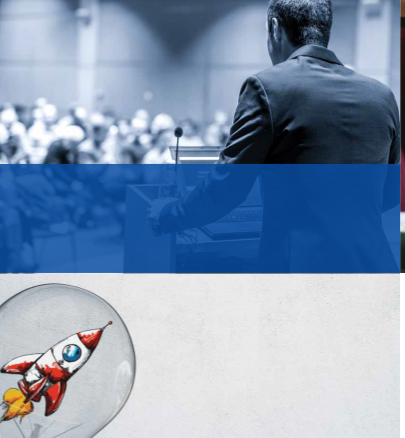
Introduction:
Social Entrepreneurship is a version of entrepreneurship that seeks to address a social or an environmental issue by presenting a specific solution to solve it. The person who is engaged in such a venture is called a social
entrepreneur, who takes up the challenge of raising social capital by means of entrepreneurship without a profit motive. The term “Social Entrepreneurship” was introduced a few decades ago by William Drayton, founder of “Ashoka”, the world’s first organization to promote social entrepreneurship (Welsh and Krueger, 2012). The concept however is much older than that; it was practiced in the 19th and 20th centuries. Personalities like Florence Nightingale, the founder
of the first nursing school and modern nursing practices; Maria Montessori, a pioneer in transforming early childhood education; Vinoba Bhave, the founder
of India’s Land Gift Movement; and Margaret Sanger, the founder and leader of the Planned Parenthood Federation of America, are social entrepreneurs who have established enterprises that supported the elimination of social problems, resulting in positive social outcomes (Raju, 2018).
More recently, Professor Mohamed Yunus, Founder of the Microfinance/ Grameen model; William Drayton, founder of Ashoka; Vickram Akula, founder of SKS Microfinance and Nick Reder, Brent Freeman and Norma
La Rosa, founders of roozi.com, are some of the social entrepreneurs who have popularized the term (www. managementstudyguide.com). In Sri Lanka too there are many organizations and individuals who strive to practice and promote the concept. Ath Pavura, a
reality TV program based on the format of Shark Tank, USA, and Dragon’s Den, UK, created a platform for budding social entrepreneurs to find investment opportunities. It is a joint initiative founded by veteran banker Chandula Abeywickrama, the founder of Lanka Impact Investing Network, and Eranda Ginige, the founder of Social Enterprise Lanka and supported by an investor pool consisting of business giants (‘tuskers’) in the country committed to social and environmental wellbeing.
At present, more and more companies and people are rallying to support
and promote social entrepreneurship to produce positive social and environmental outcomes while solving other related issues.
What is Social Entrepreneurship?
The concept has been defined by many entrepreneurs and scholars in different ways. However they all agree that it is about creating social and or environmental value, without a profit orientation.
Peredo and Mclean in their study, Social Entrepreneurship: A Critical Review
of the Concept (2006), give a more comprehensive definition of the concept covering five salient attributes based on the available literature on the concept.
Accordingly, they define it as follows: “social entrepreneurship is exercised where some person or persons (1) aim either exclusively or in some prominent way to create social value of some kind, and pursue that goal through some combination of (2) recognizing and
exploiting opportunities to create this value, (3) employing innovation, (4) tolerating risk and (5) declining to accept limitations in available resources”.
Entrepreneur vs. social entrepreneur
All entrepreneurs are driven by innovation and creativity. They strive to seek new ways to solve different problems while taking calculated risks.
A social entrepreneur is also a type of entrepreneur who takes risks and
responsibility for societal needs (Basar, P. 2018). According to Dees (2001), while contemporary entrepreneurship definitions can be applied to social entrepreneurs, social entrepreneurship is unique and is one “species of the genus entrepreneur”. He further states that wealth creation is one measure of value creation for social entrepreneurs
since their mission is not limited to pure wealth creation. This he sees as the main difference which arises from
their mission to assess the opportunities differently. As Raju (2018) describes, doing good without charity is the mission of a social entrepreneur, which in turn helps rural empowerment
for socio-economic change. As Bill Drayton said, ‘Social entrepreneurs are not content just to fish or teach how
to fish. They will not rest until they have revolutionized the entire fishing industry’ (Raju, 2017). That illustrates the basic feature of the commitment and passion of a social entrepreneur, which is why it could be more challenging compared to traditional entrepreneurship.
Table 1: The main differences between entrepreneurs and social entrepreneurs
| Entrepreneur | Social Entrepreneur |
| Tend to focus on new needs, | Tend to focus on serving more effective long-term goals through new approaches. |
| Take risks on behalf of shareholders or their nominees. | They take risks on behalf of stakeholders. |
| They try to create a [business/business?]. | They try to create a change. |
| The main motivating factor for entrepreneurs is the idea of starting a new business, starting to work on it, and getting financial gain. | The main objectives are social change from the pursuit of profit and the development of the customer group. |
| The risk of entrepreneurs leads to gain preference and respect. | Social entrepreneurs are those who take responsibility and risks for civil society needs. |
| The main purpose is profit. | They can also participate in profit-oriented activities, but they see it as a means to reach their goals. |
Source: Basar (2006), from Özdevecioğlu and Cingöz.
Page 62 www.cma-srilanka.org | Volume 07 – No. 4 – September 2019
The importance of social entrepreneurship and challenges [for growth]
Today social entrepreneurship is focused on creating value to society as well as the environment. Thus the benefits at a broader level accrue to both society and the environment. It also helps to create an empowered new generation of social entrepreneurs while contributing to the economy of the country.
Although it has distinct value creation potential by enhanced social and environmental wellbeing, there are many challenges that hinder its growth. The dialogues on this topic have brought
out some common issues that hamper the momentum of developing social entrepreneurship in Sri Lanka. They include inadequate public awareness, lack of preferential tax policies for entrepreneurs and investors and lack of government intervention to promote the concept. The issue of unawareness is an outcome of Sri Lanka’s educational system, which prepares students to become job seekers rather than job creators. Thus, the entire education system needs some revamping to support social entrepreneurship in
Sri Lanka. Furthermore, Sri Lankan industry faces challenges such as development and expansion constraints, financial and personal risks associated with setting up a social enterprise, unavailability of skilled workers and volunteers, low recognition for social enterprises, difficulty in building networks and supply chains, and accessing markets (British Council, 2018).
Thus it is evident that to reap the full benefits of social entrepreneurship, the government, investors and the general public should join together to take it forward to make a noteworthy.
AFC – A tusker in promoting social entrepreneurship through Ath Pavura
Alliance Finance Company PLC (AFC) joined Ath Pavura as a founding investor from the beginning of the programme, identifying itself as an investor to promote the social entrepreneurship for social and environmental wellbeing. Mr. Romani de Silva, the Deputy Chairman and the Managing Director, as well
as a veteran in the leasing industry of Sri Lanka represents the company in Ath Pavura as a Tusker. AFC is the third oldest finance company in Sri
Lanka, pioneers in providing leasing for three wheelers and a triple bottom line company with a strong sustainability mandate. AFC has a separate annual allocation of 3% of the profit for sustainability initiatives as well as for executable commitment.
AFC has been with Ath Pavura since its inception and has thus far invested in four social enterprises under Mission I and pledged to invest in another eight social businesses under Mission II.
The Mission I social enterprises are: AAYU drive through breakfast outlets, Organic Aloe vera project, Ecofeel foods, dehydrated vegetables and foods and Thuru Viyana (Plant Nursery).
To date the company has invested Rs.
2.3 million in Mission I and pledged another Rs. 3.4 million for Mission II.
The businesses AFC selected to invest in have been thoroughly evaluated for their social and environmental outcomes as well as innovativeness in the business concept. At the outset, the main issues the entrepreneurs faced were lack of capital for growth and little access to market linkages. Joining hands with AFC helped them to overcome the
financial constraints and empowered them to reach out for more lucrative opportunities to grow their businesses, with the expansion and establishment of new market linkages. Since the initial investments made in 2017, all the four businesses have achieved a significant level of growth and success. Going beyond the role of an investor, AFC has helped some entrepreneurs to develop their businesses by growing their assets and introducing business opportunities
that promote a circular economic model.
At present, the three food production enterprises including Aloe Vera business have reached prominent supermarket chains such as Arpico and Keells, and
a wide range of other customer outlets thus expanding their businesses and popularizing the brands. Thuru Viyana business has developed new ties with the government to produce plants for their tree planting initiatives, which has become a top priority of the government at the moment.
These businesses directly contribute to adding value to Sustainable Development Goals (SDGs). The four businesses alone contribute to the following SDGs:
AFC takes pride in paving the way to success and being able to set an example on how timely investments in the
right businesses can help to transform informal social enterprises into value creating formal enterprises. In January 2019, AFC received international recognition for its contribution to local economic development by partnering Ath Pavura, investing in social enterprises and leading them to success. The merit award was presented to AFC at the AFDIAF Awards 2019 held in Oman, organized by the Association of Development Financing Institutions in Asia and the Pacific.
Conclusion
Social entrepreneurship has been in the spotlight over the last few decades
with people and corporations engaging and investing in social enterprises.
This is largely due to the many social and environmental benefits it creates compared to traditional
entrepreneurship which is largely profit oriented.
There is a huge number of cottage level social enterprises in Sri Lanka, driven by ambitious social entrepreneurs, who cannot access the mainstream formal industry sector due to deficiencies in
entrepreneurial sense and lack of capital, market linkages and external support.
The case of AFC is evidence of how timely investment in right businesses can support growth and become formal enterprises that can add value to society and the environment thus contributing to national and global sustainability goals.
References
Basar, P. (2018). Social Entrepreneurship: Case Study in Unilever Food Solutions’ Trusted Hands Food Safety Online Training Program. Entrepreneurship – Trends and Challenges- Chapter 9.
Dees, J.G. (2001), The Meaning of “Social Entrepreneurship”, Kauffman Foundation, Kansas City, MO
Fonseka, S. (2017). Social enterprises: The importance of knowing. Retrieved from http://www.ft.lk/opinion/Social- enterprises–The-importance-of- knowing/14-645725
Juneja, P. (2015). History of Social Entrepreneurship. Retrieved from https://www.managementstudyguide. com/social-entrepreneurship-history. htm
Nayab, N. (2011). Early Social Entrepreneurship History Entrepreneurs
/ Becoming an Entrepreneur. Retrieved from https://www.brighthub.com/office/ entrepreneurs/articles/73851.aspx
Peredo, A.M., & Mclean, M. (2016). Social Entrepreneurship: A Critical Review of the Concept. Journal of World Business. 41(1), pp.56-65.
Raju P.R.K. (2018). A case study on social entrepreneurship: a catalyst for rural empowerment. National
conference on rural empowerment and entrepreneurship for socio-economic change.
The State of Social Enterprises in Sri Lanka (2018). British Council, Colombo, Sri Lanka
Welsh, D. H. B., & Krueger, N. F. (2012). The Evolution of Social Entrepreneurship: What Have We Learned? Journal of Technology Management in China. 7(3).
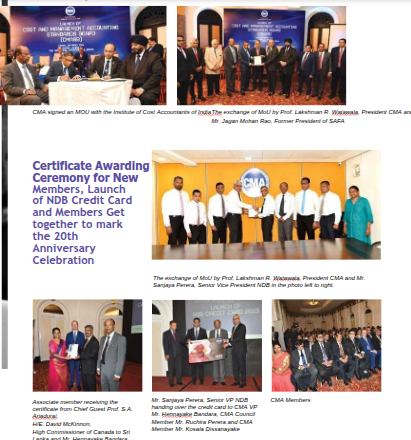
CERTIFIED MANAGEMENT ACCOUNTANT
NEWS President Confers “National Honours” on President CMA Prof. Lakshman R Watawala
Australia and Curtin University of Technology, West Australia.
The Institute of Chartered Accountants Sri Lanka inducted Prof. Watawala to its Hall of Fame in recognition of his services to the profession and the public in an illustrious career spanning decade covering the private and public sectors.
He is a Fellow of the Institute of Chartered Accountants of Sri Lanka, Chartered Institute of Management Accountants
of UK, Institute of Certified Management Accountants of Sri Lanka and Institute of Chartered Professional Managers of Sri Lanka.
President Maithripala Sirisena conferred the Sri Lanka Sikhamani on President Institute of Certified Management Accountants of Sri Lanka (CMA) Prof. Lakshman R Watawala. This is conferred for distinguished service of a general nature in honour of the outstanding service rendered by him to our great Motherland.
President Maithripala Sirisena conferred ‘National Honours’ on 70 distinguished personalities to honour the outstanding service rendered by them to the Motherland. The ceremony organized by the Presidential Secretariat was held at the BMICH on 19th August 2019.
Prof. Lakshman R Watawala is an eminent Chartered and Management Accountant who has been at the helm of key state institutions and private companies for several decades.
He founded the Institute of Certified Management Accountants of Sri Lanka paving opportunities for a vast number of Sri Lankan students to acquire professional qualifications in management accountancy
and advance in their careers at an affordable cost. He is present President of the Institute, as well as the Founder
President of the Association of Accounting Technicians of Sri Lanka set up to meet the shortage of middle level Accountants and also he is the founder of Chartered Institute of Professional Managers
Sri Lanka (CPM).
In the past Prof. Watawala has served as Chairman and Director General of the Board of Investment, Chairman of Peoples Bank, People’s Merchant Bank, Pan Asia Bank, National Insurance Trust Fund and several leading companies. He was also the President of the Association of Management Development Institute
in South Asia ( AMDISA ),South Asian Federation of Accountants(SAFA) and the Organization of Professional Associations of Sri Lanka.
He has Served on the boards of several leading academic institutions, and was appointed Adjunct Professor, Swinburne Graduate School of Management,
Prof.Watawala is an old boy of St’ Thomas’s college Mount Lavinia where he captained the school Hockey team and was the Head Prefect of the school. He served his articles at Turquand .&
Co-Chartered Accountants (Now Ernst & Young)and qualified as a chartered Accountant .
